Paul van Yperen's Blog, page 53
April 16, 2024
Axel Eliassons Konstförlag
During the 1910s and 1920s, the heydays of the Swedish film industry, film star postcards formed an important marketing tool. Besides Förlag Nordisk Konst, several other publishers in Sweden produced and distributed cards with film portraits or scenes. A major postcard publisher was Axel Eliassons Konstförlag in Stockholm. We selected 20 sepia film postcards from our collections which were published by this company which advertised itself as 'the biggest postcard company in the North'.
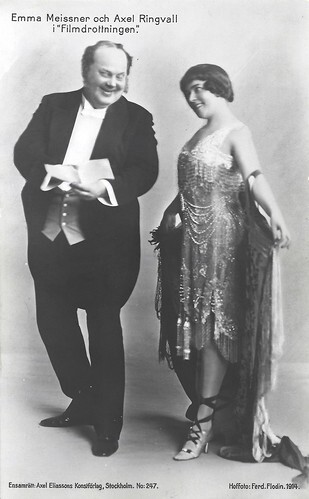
Swedish postcard by Axel Eliassons Konstförlag, Stockholm, no. 247. Photo: Hofatelier Ferd. Flodin, 1914. Emma Meissner and Axel Ringvall in the operetta 'Die Kino-Königin' (1913) by Jean Gilbert, performed as 'Filmdrottningen in Sweden.
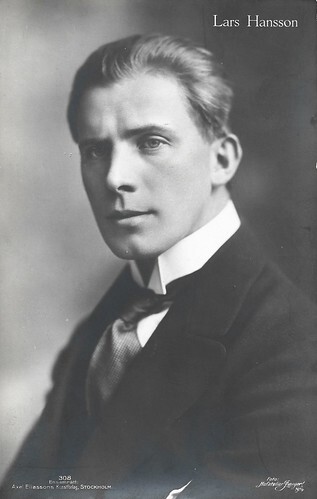
Swedish postcard by Axel Eliassons Konstförlag, Stockholm, no. 308. Photo: Hofatelier Jaeger, Stockholm, 1914. Lars Hanson .
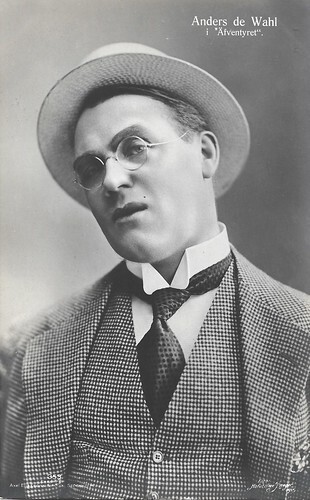
Swedish postcard by Axel Eliassons Konstförlag, Stockholm, no. 353. Photo: Hofatelier Jaeger, Stockholm, 1915. Anders de Wahl in the stage play 'Äventyret aka Äfventyret' by Valentin Le Barroyer, performed at the Dramaten theatre in Stockholm in 1915, under the direction of Karl Hedberg.
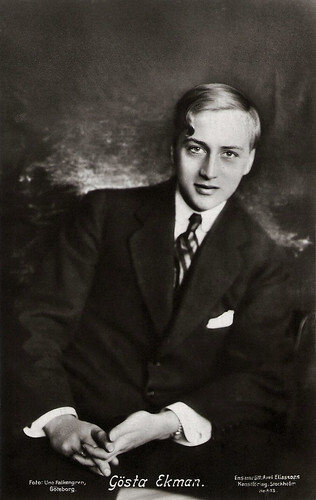
Swedish postcard by Axel Eliassons Konstförlag, Stockholm, no. 413, mailed in 1916. Photo: Uno Falkengren, Göteborg. Gösta Ekman .
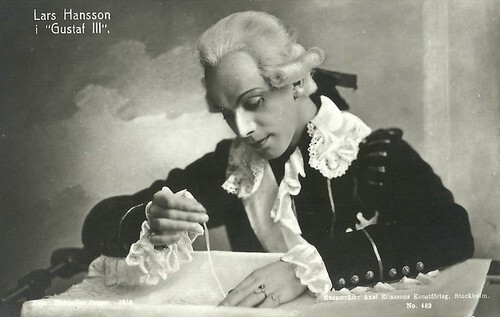
Swedish postcard by Axel Eliassons Konstförlag, Stockholm, no. 482. 'Gustav III' was a play by August Strindberg and this card refers to one of Lars Hanson 's stage play performances, not a film. Hanson played the title role in 1915 (dir. Einar Fröberg) and again in 1928 (dir. Rune Carlsten).
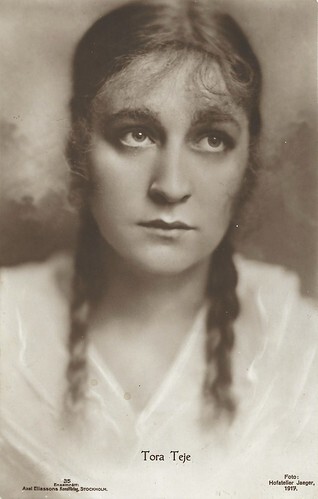
Swedish postcard by Axel Eliassons Konstförlag, Stockholm, no. 35. Photo: Hofatelier Jaeger, Stockholm, 1917. Tora Teje .
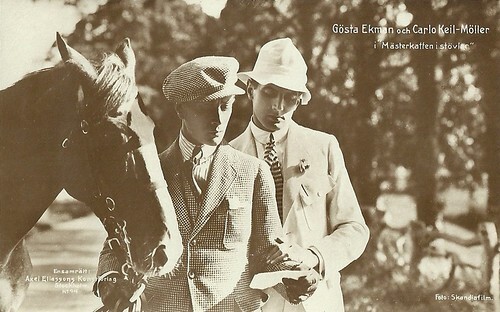
Swedish postcard by Axel Eliassons Konstförlag, Stockholm, no. 94. Photo: Skandiafilm. Gösta Ekman and Carlo Keil-Möller in the Swedish silent romantic film Mästerkatten i stövlar/Puss in boots (John W. Brunius, 1918).
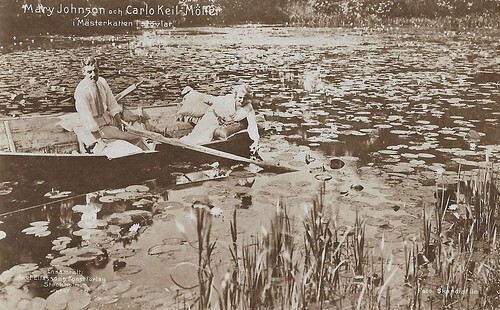
Swedish postcard by Axel Eliassons Konstförlag, Stockholm, no. 97. Photo: Skandia Film. Mary Johnson and Carlo Keil-Möller in the Swedish silent romantic film Mästerkatten i stövlar/Puss in boots (John W. Brunius, 1918).
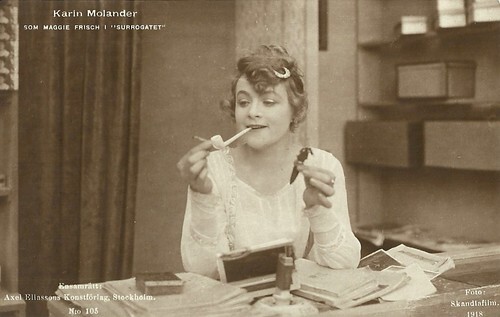
Swedish postcard by Axel Eliassons Konstförlag, Stockholm, no. 105. Photo: Skandiafilm, 1918. Karin Molander in Surrogatet (Einar Bruun, 1919).
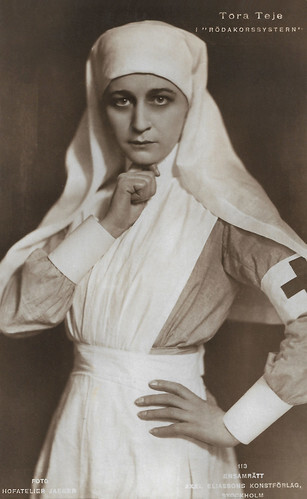
Swedish postcard by Axel Eliassons Konstförlag, Stockholm, no. 113. Photo: Hofatelier Jaeger. Tora Teje in the play 'Rödakorssystern' (Red Cross Sister) by Gustaf Collijn. The play premiered on 14 March 1919 at the Svenska Teatern. The director was Gunnar Klintberg and her co-star was Gösta Ekman.
'Swedish-made' postcards
Axel Eliassons Konstförlag (AE) was founded in Stockholm in 1890. In the first half of the 20th century. AE with its premises on the famous street Drottninggatan, was Sweden's leading producer of postcards. Founder Axel Eliasson was born on 16 February 1868 in Stockholm. He was the son of the clothing merchant Meyer Eliasson and Ida Davidsson. In 1890 he founded the company Axel Eliasson (AE) in Stockholm. He got the idea for his postcard production in Berlin, where he studied at the Rakow Economic School. Initially, Eliasson himself was behind the camera, so he was able to market his products as 'Swedish-made'.
Eliasson's first postcards were sold in the middle of 1891. These showed Stockholm and Gothenburg and were advertised in the newspaper Aftonbladet. However, these first postcards, where the image only took up 1/3 of the front page, were not very successful. Only after Eliasson changed the layout and enlarged the size of the pictures in 1896, their popularity increased. Apart from topographical postcards, Eliasson decided to produce greetings postcards for his own company but also for other companies in Scandinavia. In an interesting article in the magazine Postcard Album, Arne Sandström writes that Eliasson never printed his postcards himself. He ordered most of them from different printers in Germany (including Rotophot ) and some also from printers in Sweden, the U.K. and the U.S.A. In 1933, the company probably started to print its own cards.
In 1894 painter and illustrator Jenny Nyström was contracted to draw greeting postcards. Axel Eliasson Konstförlag had exclusive rights to postcards with her motifs of the 'jultomte' (goblins) on numerous Christmas cards, thus linking the Swedish version of Santa Claus to the gnomes of Scandinavian folklore. Her illustrated Christmas cards became one of Eliassons's main products. From 1895 the AE postcards were also published in colour lithography and in 1897 Anna Palm joined the company. She illustrated the 'official' postcards of the 1897 Stockholm Exhibition which were widely distributed. Till 1898, the AE cards were not numbered.
Axel Eliassons Konstförlag had the reproduction rights to the photographs of royalty and famous people by Atelier Jaeger, a photo studio founded in 1858 by Johannes Jaeger. Valentin Wolfenstein bought the studio in 1890, and Albin Roosval and Herman Sylwander acquired the company in 1905 and kept the name. The AE logo was introduced around 1920 and was designed by David Blomberg, who had previously designed the NK logo. In 1922, the name Konstförlag was added to the company name. Eventually, postcard motifs from all over Sweden, Denmark and Norway were published, some of which were hand-coloured. At the end of the 1930s, small booklets with ten motifs from the same city on loose photographs were available in 10x6 cm format.
Axel Eliasson died on 23 January 1932 in Stockholm. He was married to Ester Sterner (1880-1951), who after his death remarried in 1938 to Axel Widstrand, a naval doctor. After Axel Eliasson's death, his son Georg Eliasson became the managing director. The publishing house was transformed into a limited company. Axel Eliassons Konstförlag expanded until the 1920s, but its success stalled in the 1930s. In 1940 the company went bankrupt and closed. However, the liquidation was not finalised until 1941. By then the company had already been bought by Alrik Hedlund Förlag in Gothenburg, which created Nya Aktiebolaget Axel Eliassons Konstförlag. In 1943 the name was changed to Axel Eliassons Konstförlag Aktiebolag and in 1969 to Axel Eliasson Aktiebolag. When Sven-Göran Östh, previously CEO of Gerhard's Konstförlag, became CEO of the company in 1989, he decided to move the company to Sågmyra. The company still exists under the name of Axel Eliasson AB in Sågmyra. It is no longer active in the postcard business and mainly produces art publishing items such as Christmas cards and gifts.
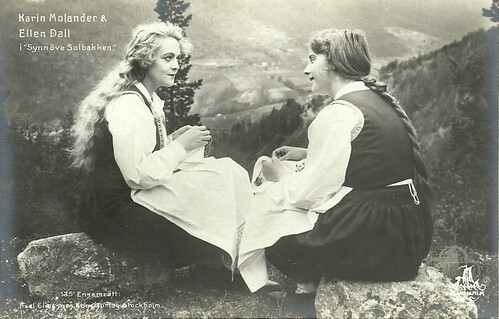
Swedish postcard by Axel Eliassons Konstförlag, Stockholm, no. 135. Photo: Skandia Film. Karin Molander and Ellen Dall in Synnöve Solbakken (John W. Brunius, 1919), adapted from Bjørnstjerne Bjørnson's Norwegian homonymous novel (1857).
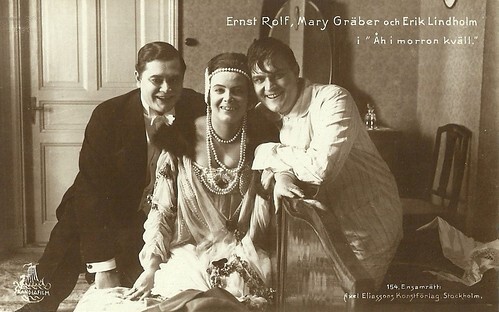
Swedish postcard by Axel Eliassons Konstförlag, Stockholm, no. 154. Photo: Skandia Film. Ernst Rolf, Mary Gräber, and Erik Lindholm in the Swedish silent comedy Åh i morron kväll/Oh Tomorrow Night!, (John W. Brunius, 1919).
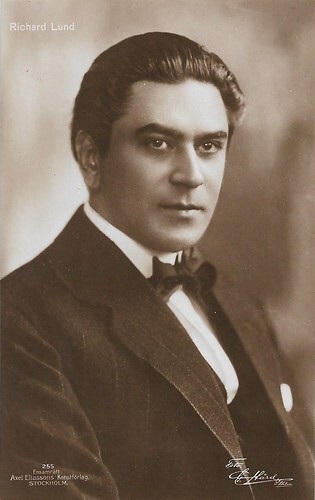
Swedish postcard by Axel Eliassons Konstförlag, Stockholm, no. 255. Photo: Gösta Hard. Richard Lund .
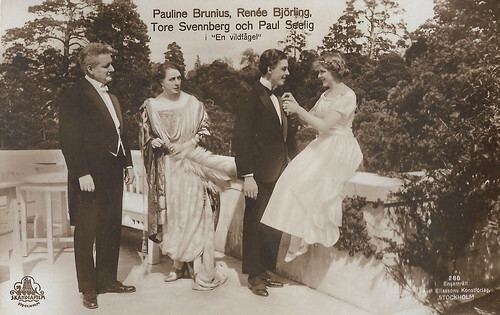
Swedish postcard by Axel Eliassons Konstförlag, Stockholm, no. 288. Photo: Skandia-Film. Pauline Brunius , Tore Svennberg, Renée Björling and Paul Seelig in the Swedish silent drama En vildfågel/Give Me My Son (John W. Brunius, 1921). Adapted from the play 'Skeppsbrott' (Shipwreck) by Samuel A. Duse. The title translates literally as 'The Wild Bird'. On 3 October 1921, En vildfågel premiered simultaneously in five cinemas in five Swedish cities.
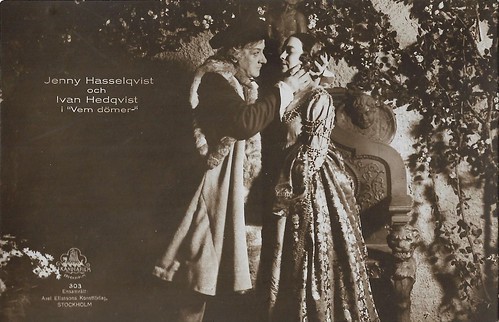
Swedish postcard by Axel Eliassons Konstförlag, Stockholm, no. 303. Photo: Skandia Film, Stockholm. Jenny Hasselqvist and Ivan Hedqvist in the Swedish silent film Vem dömer/Love's Crucible (Victor Sjöström, Skandia Film 1922). The film is a Renaissance drama where a young woman named Ursula (Jenny Hasselquist), who is in love with Bertram, the son (Gösta Ekman) of the mayor (Tore Svenberg), is accused of having poisoned her older husband, the sculptor Master Anton (Ivan Hedqvist). She has to prove her virginity through a fire test. The film's title reads: Who judges?
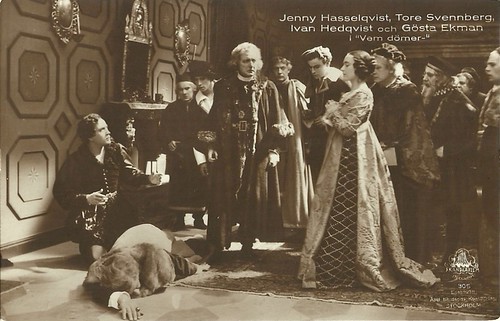
Swedish postcard by Axel Eliassons Konstforlag, Stockholm, no. 305. Photo: Skandia Film, Stockholm. Jenny Hasselqvist, Ivan Hedqvist, Tore Svennberg and Gösta Ekman in the Swedish silent film Vem döme/ Love's Crucible, (Victor Sjöström, 1922). The film is a Renaissance drama where a young woman named Ursula (Hasselqvist), who is in love with Bertram, the son (Ekman) of the mayor (Svenberg), is accused of having poisoned her older husband, the sculptor Master Anton (Hedqvist). She has to prove her virginity through a fire test. The film's title reads: Who judges? NB Nils Asther had a small part in this film. He is the man just left of Hasselquist.
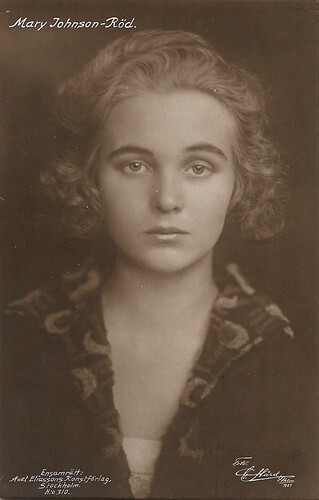
Swedish postcard by Axel Eliassons Konstförlag, Stockholm, no. 310. Photo: Gösta Hard, Stockholm, 1927. On this postcard, Mary Johnson is indicated with the name of her second husband.
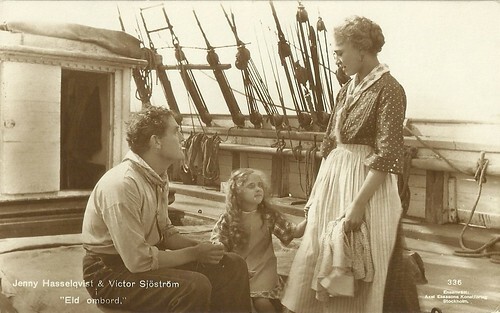
Swedish postcard by Ed. Axel Eliassons Konstförlag, Stockholm, no. 336. Photo: Svensk Filminspelning. Victor Sjöström and Jenny Hasselquist in Eld ombord/Fire on board (Victor Sjöström, 1923).
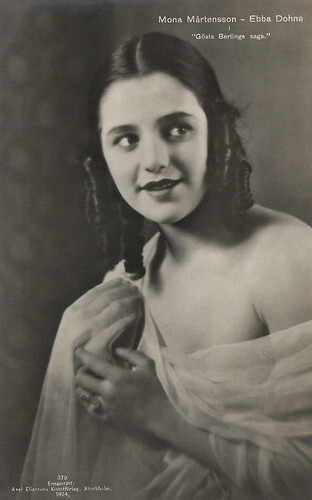
Swedish postcard by Axel Eliassons Konstförlag, Stockholm, no. 379, 1924. Photo: Svenska-Film. Mona Mårtenson as Ebba Dohna in Gösta Berlings saga/The Atonement of Gosta Berling (Mauritz Stiller, 1924), based on the novel by Selma Lagerlöf.
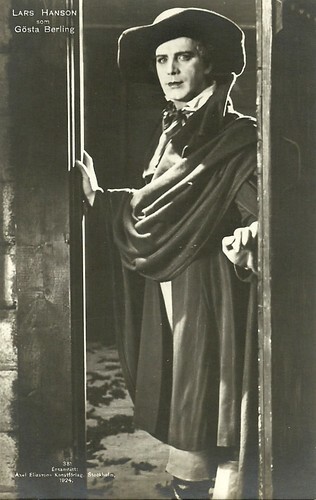
Swedish postcard by Axel Eliassons Konstförlag, Stockholm, no. 381. Lars Hanson is the title character in Gösta Berlings saga/The Saga of Gösta Berling (Mauritz Stiller 1924). The film was an adaptation of the famous novel by Selma Lagerlöf. The cinematography was by Julius Jaenzon and the art direction was by Vilhelm Bryde with Edgar Ulmer collaborating on the set design.
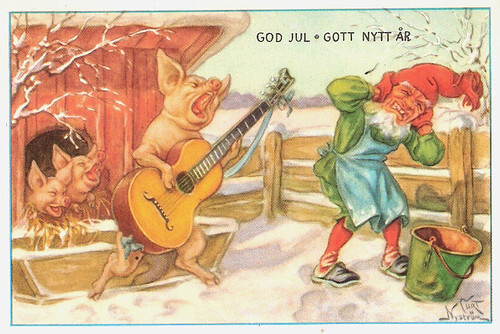
Small Swedish postcard by Axel Eliassons Konstförlag A.B., Stockholm. Illustration: Curt Nyström. Sent by mail in 1960. Curt Nyström was the son of Jenny Nyström who followed in her footsteps and became a popular postcard and poster artist, staying very close to his mother's artistic style.
Sources: Arne Sandström (The Postcard Album #39), Wikipedia (Swedish) and Jean Ritsema (Ross Postcards).

Swedish postcard by Axel Eliassons Konstförlag, Stockholm, no. 247. Photo: Hofatelier Ferd. Flodin, 1914. Emma Meissner and Axel Ringvall in the operetta 'Die Kino-Königin' (1913) by Jean Gilbert, performed as 'Filmdrottningen in Sweden.

Swedish postcard by Axel Eliassons Konstförlag, Stockholm, no. 308. Photo: Hofatelier Jaeger, Stockholm, 1914. Lars Hanson .

Swedish postcard by Axel Eliassons Konstförlag, Stockholm, no. 353. Photo: Hofatelier Jaeger, Stockholm, 1915. Anders de Wahl in the stage play 'Äventyret aka Äfventyret' by Valentin Le Barroyer, performed at the Dramaten theatre in Stockholm in 1915, under the direction of Karl Hedberg.

Swedish postcard by Axel Eliassons Konstförlag, Stockholm, no. 413, mailed in 1916. Photo: Uno Falkengren, Göteborg. Gösta Ekman .

Swedish postcard by Axel Eliassons Konstförlag, Stockholm, no. 482. 'Gustav III' was a play by August Strindberg and this card refers to one of Lars Hanson 's stage play performances, not a film. Hanson played the title role in 1915 (dir. Einar Fröberg) and again in 1928 (dir. Rune Carlsten).

Swedish postcard by Axel Eliassons Konstförlag, Stockholm, no. 35. Photo: Hofatelier Jaeger, Stockholm, 1917. Tora Teje .

Swedish postcard by Axel Eliassons Konstförlag, Stockholm, no. 94. Photo: Skandiafilm. Gösta Ekman and Carlo Keil-Möller in the Swedish silent romantic film Mästerkatten i stövlar/Puss in boots (John W. Brunius, 1918).

Swedish postcard by Axel Eliassons Konstförlag, Stockholm, no. 97. Photo: Skandia Film. Mary Johnson and Carlo Keil-Möller in the Swedish silent romantic film Mästerkatten i stövlar/Puss in boots (John W. Brunius, 1918).

Swedish postcard by Axel Eliassons Konstförlag, Stockholm, no. 105. Photo: Skandiafilm, 1918. Karin Molander in Surrogatet (Einar Bruun, 1919).

Swedish postcard by Axel Eliassons Konstförlag, Stockholm, no. 113. Photo: Hofatelier Jaeger. Tora Teje in the play 'Rödakorssystern' (Red Cross Sister) by Gustaf Collijn. The play premiered on 14 March 1919 at the Svenska Teatern. The director was Gunnar Klintberg and her co-star was Gösta Ekman.
'Swedish-made' postcards
Axel Eliassons Konstförlag (AE) was founded in Stockholm in 1890. In the first half of the 20th century. AE with its premises on the famous street Drottninggatan, was Sweden's leading producer of postcards. Founder Axel Eliasson was born on 16 February 1868 in Stockholm. He was the son of the clothing merchant Meyer Eliasson and Ida Davidsson. In 1890 he founded the company Axel Eliasson (AE) in Stockholm. He got the idea for his postcard production in Berlin, where he studied at the Rakow Economic School. Initially, Eliasson himself was behind the camera, so he was able to market his products as 'Swedish-made'.
Eliasson's first postcards were sold in the middle of 1891. These showed Stockholm and Gothenburg and were advertised in the newspaper Aftonbladet. However, these first postcards, where the image only took up 1/3 of the front page, were not very successful. Only after Eliasson changed the layout and enlarged the size of the pictures in 1896, their popularity increased. Apart from topographical postcards, Eliasson decided to produce greetings postcards for his own company but also for other companies in Scandinavia. In an interesting article in the magazine Postcard Album, Arne Sandström writes that Eliasson never printed his postcards himself. He ordered most of them from different printers in Germany (including Rotophot ) and some also from printers in Sweden, the U.K. and the U.S.A. In 1933, the company probably started to print its own cards.
In 1894 painter and illustrator Jenny Nyström was contracted to draw greeting postcards. Axel Eliasson Konstförlag had exclusive rights to postcards with her motifs of the 'jultomte' (goblins) on numerous Christmas cards, thus linking the Swedish version of Santa Claus to the gnomes of Scandinavian folklore. Her illustrated Christmas cards became one of Eliassons's main products. From 1895 the AE postcards were also published in colour lithography and in 1897 Anna Palm joined the company. She illustrated the 'official' postcards of the 1897 Stockholm Exhibition which were widely distributed. Till 1898, the AE cards were not numbered.
Axel Eliassons Konstförlag had the reproduction rights to the photographs of royalty and famous people by Atelier Jaeger, a photo studio founded in 1858 by Johannes Jaeger. Valentin Wolfenstein bought the studio in 1890, and Albin Roosval and Herman Sylwander acquired the company in 1905 and kept the name. The AE logo was introduced around 1920 and was designed by David Blomberg, who had previously designed the NK logo. In 1922, the name Konstförlag was added to the company name. Eventually, postcard motifs from all over Sweden, Denmark and Norway were published, some of which were hand-coloured. At the end of the 1930s, small booklets with ten motifs from the same city on loose photographs were available in 10x6 cm format.
Axel Eliasson died on 23 January 1932 in Stockholm. He was married to Ester Sterner (1880-1951), who after his death remarried in 1938 to Axel Widstrand, a naval doctor. After Axel Eliasson's death, his son Georg Eliasson became the managing director. The publishing house was transformed into a limited company. Axel Eliassons Konstförlag expanded until the 1920s, but its success stalled in the 1930s. In 1940 the company went bankrupt and closed. However, the liquidation was not finalised until 1941. By then the company had already been bought by Alrik Hedlund Förlag in Gothenburg, which created Nya Aktiebolaget Axel Eliassons Konstförlag. In 1943 the name was changed to Axel Eliassons Konstförlag Aktiebolag and in 1969 to Axel Eliasson Aktiebolag. When Sven-Göran Östh, previously CEO of Gerhard's Konstförlag, became CEO of the company in 1989, he decided to move the company to Sågmyra. The company still exists under the name of Axel Eliasson AB in Sågmyra. It is no longer active in the postcard business and mainly produces art publishing items such as Christmas cards and gifts.

Swedish postcard by Axel Eliassons Konstförlag, Stockholm, no. 135. Photo: Skandia Film. Karin Molander and Ellen Dall in Synnöve Solbakken (John W. Brunius, 1919), adapted from Bjørnstjerne Bjørnson's Norwegian homonymous novel (1857).

Swedish postcard by Axel Eliassons Konstförlag, Stockholm, no. 154. Photo: Skandia Film. Ernst Rolf, Mary Gräber, and Erik Lindholm in the Swedish silent comedy Åh i morron kväll/Oh Tomorrow Night!, (John W. Brunius, 1919).

Swedish postcard by Axel Eliassons Konstförlag, Stockholm, no. 255. Photo: Gösta Hard. Richard Lund .

Swedish postcard by Axel Eliassons Konstförlag, Stockholm, no. 288. Photo: Skandia-Film. Pauline Brunius , Tore Svennberg, Renée Björling and Paul Seelig in the Swedish silent drama En vildfågel/Give Me My Son (John W. Brunius, 1921). Adapted from the play 'Skeppsbrott' (Shipwreck) by Samuel A. Duse. The title translates literally as 'The Wild Bird'. On 3 October 1921, En vildfågel premiered simultaneously in five cinemas in five Swedish cities.

Swedish postcard by Axel Eliassons Konstförlag, Stockholm, no. 303. Photo: Skandia Film, Stockholm. Jenny Hasselqvist and Ivan Hedqvist in the Swedish silent film Vem dömer/Love's Crucible (Victor Sjöström, Skandia Film 1922). The film is a Renaissance drama where a young woman named Ursula (Jenny Hasselquist), who is in love with Bertram, the son (Gösta Ekman) of the mayor (Tore Svenberg), is accused of having poisoned her older husband, the sculptor Master Anton (Ivan Hedqvist). She has to prove her virginity through a fire test. The film's title reads: Who judges?

Swedish postcard by Axel Eliassons Konstforlag, Stockholm, no. 305. Photo: Skandia Film, Stockholm. Jenny Hasselqvist, Ivan Hedqvist, Tore Svennberg and Gösta Ekman in the Swedish silent film Vem döme/ Love's Crucible, (Victor Sjöström, 1922). The film is a Renaissance drama where a young woman named Ursula (Hasselqvist), who is in love with Bertram, the son (Ekman) of the mayor (Svenberg), is accused of having poisoned her older husband, the sculptor Master Anton (Hedqvist). She has to prove her virginity through a fire test. The film's title reads: Who judges? NB Nils Asther had a small part in this film. He is the man just left of Hasselquist.

Swedish postcard by Axel Eliassons Konstförlag, Stockholm, no. 310. Photo: Gösta Hard, Stockholm, 1927. On this postcard, Mary Johnson is indicated with the name of her second husband.

Swedish postcard by Ed. Axel Eliassons Konstförlag, Stockholm, no. 336. Photo: Svensk Filminspelning. Victor Sjöström and Jenny Hasselquist in Eld ombord/Fire on board (Victor Sjöström, 1923).

Swedish postcard by Axel Eliassons Konstförlag, Stockholm, no. 379, 1924. Photo: Svenska-Film. Mona Mårtenson as Ebba Dohna in Gösta Berlings saga/The Atonement of Gosta Berling (Mauritz Stiller, 1924), based on the novel by Selma Lagerlöf.

Swedish postcard by Axel Eliassons Konstförlag, Stockholm, no. 381. Lars Hanson is the title character in Gösta Berlings saga/The Saga of Gösta Berling (Mauritz Stiller 1924). The film was an adaptation of the famous novel by Selma Lagerlöf. The cinematography was by Julius Jaenzon and the art direction was by Vilhelm Bryde with Edgar Ulmer collaborating on the set design.

Small Swedish postcard by Axel Eliassons Konstförlag A.B., Stockholm. Illustration: Curt Nyström. Sent by mail in 1960. Curt Nyström was the son of Jenny Nyström who followed in her footsteps and became a popular postcard and poster artist, staying very close to his mother's artistic style.
Sources: Arne Sandström (The Postcard Album #39), Wikipedia (Swedish) and Jean Ritsema (Ross Postcards).
Published on April 16, 2024 22:00
April 15, 2024
Lonny Kellner
Lonny Kellner (1930-2003) was a German Schlager singer and actress. She was married to comedian and radio and television personality Peter Frankenfeld.
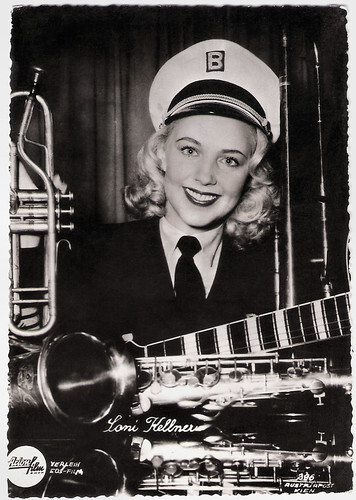
Austrian postcard by Austriapost, Wien, no. 396. Photo: Arion Film-Verleih. Lonny Kellner is written on the postcard as Loni (sic) Kellner.
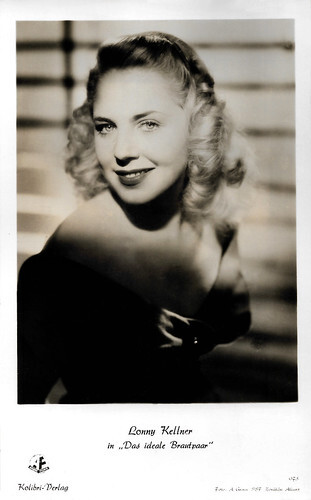
German postcard by Kolibri-Verlag, no. 678. Photo: Arthur Grimm / BBF-Nordfilm / Allianz. Lonny Kellner in Das ideale Brautpaar/The ideal bride and groom (Robert A. Stemmle, 1954).
Reaching the top ranks of the US charts
Lonny Kellner was born in 1930 in Remscheid, Germany. Lonny grew up in Remscheid, took acting lessons after her school education and began studying singing.
Her first roles followed at the Bonn Stadttheater and then at the Westfälisches Landestheater in classics such as 'Minna von Barnhelm' by Gotthold Ephraim Lessing, 'Scampolo' by Dario Niccodemi and 'Die versunkene Glocke' (The Sunken Bell) by Gerhart Hauptmann.
In 1948, through the recommendation of colleagues, she performed a few Schlager songs at the NWDR radio station in Cologne. She made her debut with the songs 'Wenn ich dich seh', dann fange ich zu träumen an' and 'Gib mir einen Kuss durchs Telefon'. Cabaret shows, radio plays and orchestral recordings for many radio stations soon followed.
She sang her first big hits 'Im Hafen von Adano' and 'La-Le-Lu' as a duet with René Carol. In 1952 Kellner made her first film appearance as a pop singer with the song 'Manhattan-Boogie' in the West German musical drama Königin der Arena/Queen of the Arena (Rolf Meyer, 1952) starring Maria Litto . This was followed by the films Tanzende Sterne/Dancing Stars (Géza von Cziffra, 1952) starring Germaine Damar , Die Blume von Hawaii/The Flower of Hawaii (Géza von Cziffra, 1953), Geld aus der Luft/Money from the Air (Géza von Cziffra, 1954) starring Josef Meinrad.
She co-starred in Keine Angst vor Schwiegermüttern/Don't Worry About Your Mother-in-Law (Erich Engels, 1954) with Grethe Weiser as her mother, Das ideale Brautpaar/The Perfect Couple (Robert A. Stemmle, 1954), and Auf Wiedersehen am Bodensee/I'll See You at Lake Constance (Hans Albin, 1956). She achieved great success with such film songs as 'So ein Tag, so wunderschön wie heute' and 'Du, du, lass mein kleines Herz in Ruh'. She even managed to reach the top ranks of the US charts.
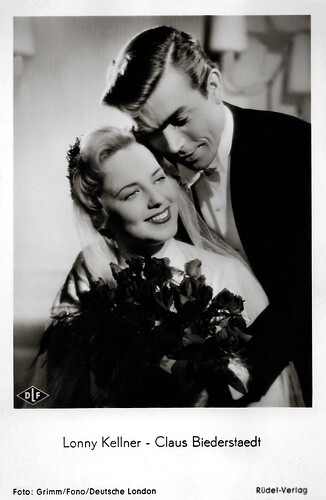
German postcard by Rüdel-Verlag, Hamburg-Bergedorf, no. 1127. Photo: Arthur Grimm / Fono / Deutsche London. Lonny Kellner and Claus Biederstaedt in Keine Angst vor Schwiegermüttern/No fear of mothers-in-law (Erich Engels, 1954).
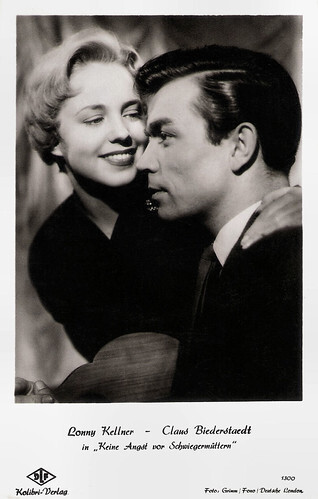
German postcard by Kolibri-Verlag, Hamburg-Bergedorf, no. 1300. Photo: Arthur Grimm / Fono / Deutsche London. Lonny Kellner and Claus Biederstaedt in Keine Angst vor Schwiegermüttern/No fear of mothers-in-law (Erich Engels, 1954).
Peter Frankenfeld
In 1956, Lonny Kellner turned down a career in the United States to marry entertainer Peter Frankenfeld, whom she had met on a joint tour. Max Schmeling and his wife Anny Ondra were witnesses at the wedding. The violinist Helmut Zacharias played 'Lullaby of Birdland'.
Frankenfeld adopted her son Thomas, born in 1951, from a previous relationship. After their marriage, Lonny Kellner-Frankenfeld and Peter Frankenfeld stood together more often in front of cameras and microphones and did shows and tours together.
The couple set up a recording studio in their house in Wedel, Holstein, where they produced sketches for radio and TV programmes such as the duets 'Bum-Budi-Bum' and 'Ich bin der Herr im Haus'. She completed an apprenticeship so that she could also work for Frankenfeld as a quasi-secretary.
After Frankenfeld's unexpected death in 1979, Kellner-Frankenfeld worked as an actress again. She appeared in 39 episodes of the family series Unsere Hagenbecks/Our Hagenbecks (1991-1994) and made guest appearances in the ZDF series Das Traumschiff/The Dream Ship (1983-1987). She also played leading roles in Ein unvergessliches Wochenende/An unforgettable weekend, an episode of the TV series Großstadtrevier/Big city district (2001) and in two episodes of Heimatgeschichten/Home stories (1998-2003).
Her last film role was in the romantic comedy Otto - Der Liebesfilm/Otto - The love film (Otto Waalkes, Bernd Eilert, 1992) starring Otto Waalkes . In memory of Frankenfeld, she endowed the Peter Frankenfeld Award for artistic versatility and humanitarian commitment in 2000. Lonny Kellner died of bone cancer in 2003 in Hamburg, Germany, at 72. Her first husband was Werner Labriga.
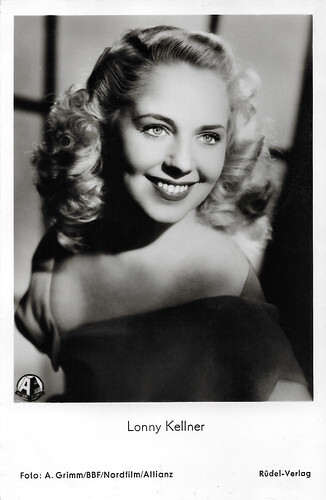
German postcard by Rüdel-Verlag, Hamburg-Bergedorf, no. 793. Photo: Arthur Grimm / BBF-Nordfilm / Allianz. Lonny Kellner in Das ideale Brautpaar/The ideal bride and groom (Robert A. Stemmle, 1954).
Sources: Wikipedia (German and English) and .

Austrian postcard by Austriapost, Wien, no. 396. Photo: Arion Film-Verleih. Lonny Kellner is written on the postcard as Loni (sic) Kellner.

German postcard by Kolibri-Verlag, no. 678. Photo: Arthur Grimm / BBF-Nordfilm / Allianz. Lonny Kellner in Das ideale Brautpaar/The ideal bride and groom (Robert A. Stemmle, 1954).
Reaching the top ranks of the US charts
Lonny Kellner was born in 1930 in Remscheid, Germany. Lonny grew up in Remscheid, took acting lessons after her school education and began studying singing.
Her first roles followed at the Bonn Stadttheater and then at the Westfälisches Landestheater in classics such as 'Minna von Barnhelm' by Gotthold Ephraim Lessing, 'Scampolo' by Dario Niccodemi and 'Die versunkene Glocke' (The Sunken Bell) by Gerhart Hauptmann.
In 1948, through the recommendation of colleagues, she performed a few Schlager songs at the NWDR radio station in Cologne. She made her debut with the songs 'Wenn ich dich seh', dann fange ich zu träumen an' and 'Gib mir einen Kuss durchs Telefon'. Cabaret shows, radio plays and orchestral recordings for many radio stations soon followed.
She sang her first big hits 'Im Hafen von Adano' and 'La-Le-Lu' as a duet with René Carol. In 1952 Kellner made her first film appearance as a pop singer with the song 'Manhattan-Boogie' in the West German musical drama Königin der Arena/Queen of the Arena (Rolf Meyer, 1952) starring Maria Litto . This was followed by the films Tanzende Sterne/Dancing Stars (Géza von Cziffra, 1952) starring Germaine Damar , Die Blume von Hawaii/The Flower of Hawaii (Géza von Cziffra, 1953), Geld aus der Luft/Money from the Air (Géza von Cziffra, 1954) starring Josef Meinrad.
She co-starred in Keine Angst vor Schwiegermüttern/Don't Worry About Your Mother-in-Law (Erich Engels, 1954) with Grethe Weiser as her mother, Das ideale Brautpaar/The Perfect Couple (Robert A. Stemmle, 1954), and Auf Wiedersehen am Bodensee/I'll See You at Lake Constance (Hans Albin, 1956). She achieved great success with such film songs as 'So ein Tag, so wunderschön wie heute' and 'Du, du, lass mein kleines Herz in Ruh'. She even managed to reach the top ranks of the US charts.

German postcard by Rüdel-Verlag, Hamburg-Bergedorf, no. 1127. Photo: Arthur Grimm / Fono / Deutsche London. Lonny Kellner and Claus Biederstaedt in Keine Angst vor Schwiegermüttern/No fear of mothers-in-law (Erich Engels, 1954).

German postcard by Kolibri-Verlag, Hamburg-Bergedorf, no. 1300. Photo: Arthur Grimm / Fono / Deutsche London. Lonny Kellner and Claus Biederstaedt in Keine Angst vor Schwiegermüttern/No fear of mothers-in-law (Erich Engels, 1954).
Peter Frankenfeld
In 1956, Lonny Kellner turned down a career in the United States to marry entertainer Peter Frankenfeld, whom she had met on a joint tour. Max Schmeling and his wife Anny Ondra were witnesses at the wedding. The violinist Helmut Zacharias played 'Lullaby of Birdland'.
Frankenfeld adopted her son Thomas, born in 1951, from a previous relationship. After their marriage, Lonny Kellner-Frankenfeld and Peter Frankenfeld stood together more often in front of cameras and microphones and did shows and tours together.
The couple set up a recording studio in their house in Wedel, Holstein, where they produced sketches for radio and TV programmes such as the duets 'Bum-Budi-Bum' and 'Ich bin der Herr im Haus'. She completed an apprenticeship so that she could also work for Frankenfeld as a quasi-secretary.
After Frankenfeld's unexpected death in 1979, Kellner-Frankenfeld worked as an actress again. She appeared in 39 episodes of the family series Unsere Hagenbecks/Our Hagenbecks (1991-1994) and made guest appearances in the ZDF series Das Traumschiff/The Dream Ship (1983-1987). She also played leading roles in Ein unvergessliches Wochenende/An unforgettable weekend, an episode of the TV series Großstadtrevier/Big city district (2001) and in two episodes of Heimatgeschichten/Home stories (1998-2003).
Her last film role was in the romantic comedy Otto - Der Liebesfilm/Otto - The love film (Otto Waalkes, Bernd Eilert, 1992) starring Otto Waalkes . In memory of Frankenfeld, she endowed the Peter Frankenfeld Award for artistic versatility and humanitarian commitment in 2000. Lonny Kellner died of bone cancer in 2003 in Hamburg, Germany, at 72. Her first husband was Werner Labriga.

German postcard by Rüdel-Verlag, Hamburg-Bergedorf, no. 793. Photo: Arthur Grimm / BBF-Nordfilm / Allianz. Lonny Kellner in Das ideale Brautpaar/The ideal bride and groom (Robert A. Stemmle, 1954).
Sources: Wikipedia (German and English) and .
Published on April 15, 2024 22:00
April 14, 2024
Photo by Rudolf Dührkoop & Atelier Dührkoop
Rudolf Dührkoop (1848-1918) was a Hamburg-based studio photographer, who from 1909 onward had a portrait studio in Berlin. When he died his talented daughter Minya Dührkoop (1873-1929) took over the studio. In the early 1930s, the company was called Gerstenberg-Dührkoop. Yet, in the postwar years, the name Dührkoop was used again for photos made for the new Ufa.
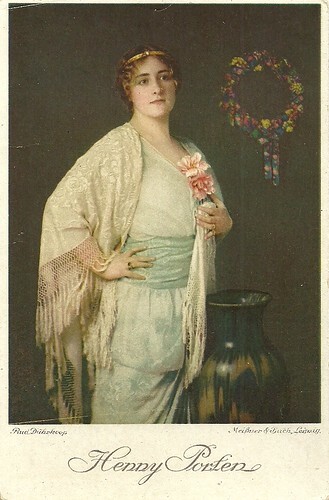
German postcard by Meissner & Buch, Leipzig. Photo: Rud. Dührkoop.
Sturdy and blond Henny Porten (1890-1960) was one of Germany's most important and popular film actresses of silent cinema. She became the quintessence of German womanhood, ladylike yet kindhearted and a not a little petit bourgeois. She was also the producer of many of her films.
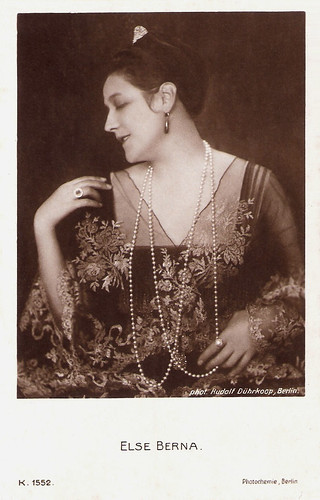
German postcard by Photochemie, Berlin, no. K. 1552. Photo: Rudolph Dührkoop, Berlin.
Actress and singer Else Berna appeared in 13 silent German films between 1917 and 1924.
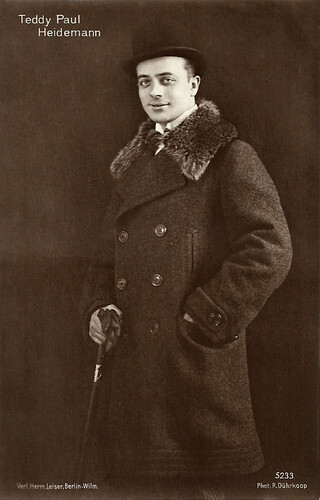
German postcard by Verlag Hermann Leiser, Berlin-Wilm., no. 5233. Photo: R. Dührkoop.
Paul Heidemann (1884-1968) was a German stage and screen actor, film director and film producer. He was famous for his comical parts.
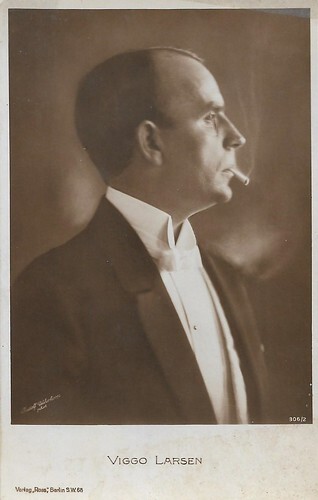
German postcard by Ross Verlag, Berlin, no. 306/2, 1919-1924. Photo: Rudolf Dührkoop.
Viggo Larsen (1880-1957) was a Danish actor, director, scriptwriter and producer. He was one of the pioneers in film history. With Wanda Treumann he directed and produced many German films of the 1910s.
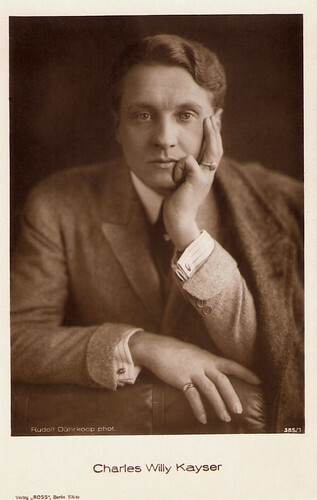
German postcard by Ross Verlag, Berlin, no. 385/1, 1919-1924. Photo: Rudolph Dührkoop.
German actor Charles Willy Kayser (1881-1942) had a remarkable career in the silent cinema. However, today he is little known, while many of his films are considered lost now and there is little information about his work.
Rudolf Dührkoop
Hamburg-based photographer Rudolf Dührkoop (1848-1918) made portrait photos and also took artistic photographs in the style of Pictorialism. Rudolf Johannes Dührkoop was born in 1848, the son of carpenter Christian Friederich Dührkoop and Johanna Friederica Emile. When the Franco-Prussian War broke out in 1870, Dührkoop volunteered to join Infantry Regiment No. 76 and was sent to Paris as an ordinary soldier after the capitulation. In 1872, he returned home, went into business and married Maria Louise Caroline Matzen, with whom he had two daughters, Hanna Maria Theresia, born in 1872, and Julie Wilhelmine, born in 1874.
Dührkoop first worked as a railway employee and then as a merchant. It was during this time that he became interested in photography. Dührkoop acquired the necessary knowledge over the years and familiarised himself with the necessary photographic processes and optics. In 1882, he published his first photograph in Photographisches Wochenblatt, the magazine of the Photographischer Verein zu Berlin. At the end of 1882, Dührkoop applied to the Hamburg Chamber of Commerce for a photographer's licence, which was granted in January 1883.
In 1883, he opened a studio at Große Bäckerstraße 26 in Hamburg and effectively became a professional photographer without any training. Dührkoop began his professional career by making 'Cartes-de-Visite', a kind of business cards with small photographs. In addition, he mainly took portrait photos. He quickly gained success. Just six months after opening his studio, he moved to Hopfenmarkt. He was often asked to photograph prominent German personalities and joined the leading 'Deutschen Photographen-Verein' in 1886.
In 1888, Dührkoop moved into a studio in Ferdinandstraße and two years later, he opened an additional studio in Altona. Over the years, Dührkoop began to take reportage photographs. Outside his studio, he photographed, among other things, a celebration of the 25th anniversary of the 76th Regiment on the Heiligengeistfeld in 1891 and a festive scene on the Hopfenmarkt in 1892 on the occasion of a 50-year celebration to commemorate the outbreak of the Hamburg fire. He showed artistic aspirations and in 1898 he held his first exhibition, with a series of pictorialist portraits of his daughter Minya. From then on, his fame rose all over Germany and later internationally. He opened another studio in Berlin, published in leading photographic magazines such as Die Kunst in der Photographie and also wrote articles on portrait photography.
In 1904, he participated in the Louisiana Purchase Exposition in Saint Louis, where he came into contact with well-known pictorialist art photographers such as Gertrude Käsebier. In 1905, he became the first German member of the prestigious English Royal Photographic Society and in 1906 of the pictorialist photography society Linked Ring. At the time, photographic societies organised exhibitions of photographic works by their members and invited photographers. At regular meetings, the members informed themselves about the latest developments. At such meetings, Dührkoop spoke, for example, about the experiences and successes of his trip to America in 1904. In addition to his artistic work, Rudolf Dührkoop always remained active as a portrait photographer and captured a large number of well-known German personalities on film during his career.
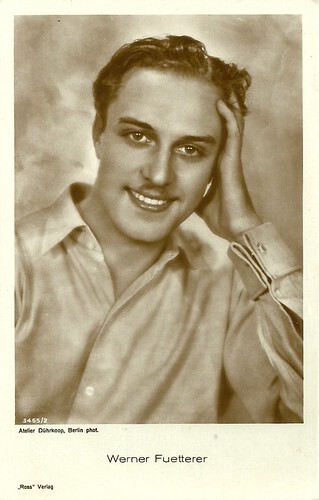
German postcard by Ross Verlag, no. 3465/2, 1928-1929. Photo: Atelier Dührkoop, Berlin.
At the age of 18, German actor Werner Fuetterer (1907-1991) was discovered to play the young lover in a series of silent films. For more than four decades he went on to work as a supporting actor in nearly 100 films.
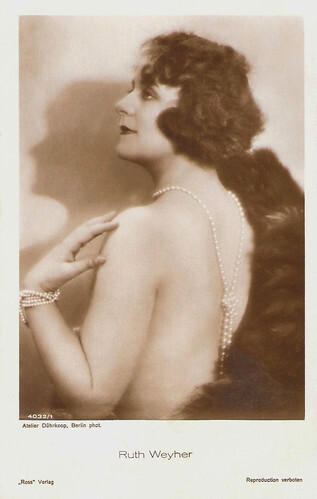
German postcard by Ross Verlag, no. 4032/1, 1929-1930. Photo: Atelier Dührkoop, Berlin.
Ruth Weyher (1901-1983) was a German actress of the silent cinema.
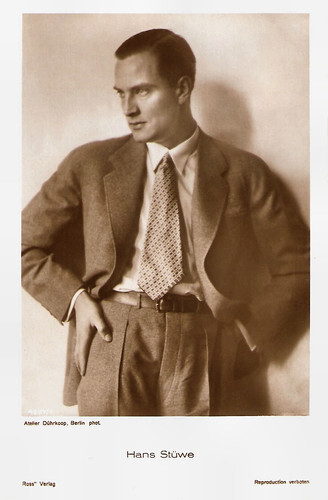
German postcard by Ross Verlag, no. 4237/1, 1929-1930. Photo: Atelier Dührkoop, Berlin.
Hans Stüwe (1901-1976) was a German singer and opera director. From 1926 on he was also a big film star in Germany. Four times he was the film partner of Ufa diva Zarah Leander.
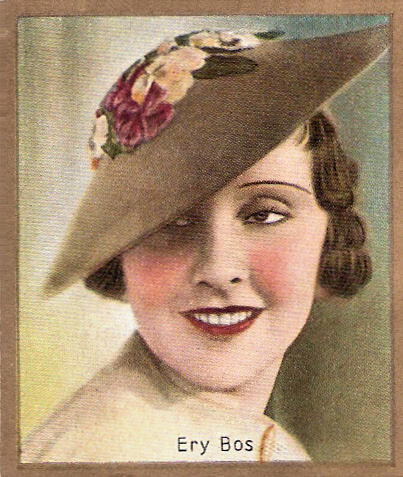
German collectors card by Salem Zigaretten in the series Bunte Filmbilder, no. 269 (in a series of 275). Photo: Dührkoop / Ross Verlag.
Dutch-German actress Ery Bos (1910-2005) had a short but productive film career in the early German sound film. In only three years, from 1932 to 1934, she took part in a dozen films.
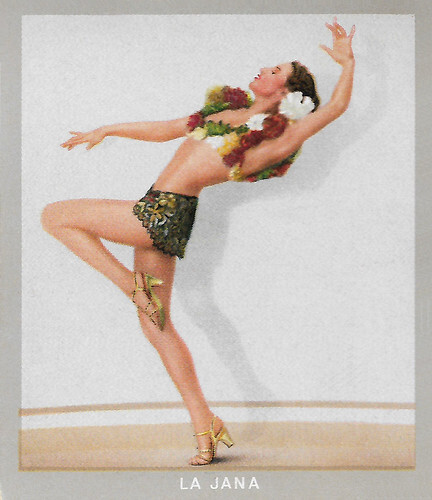
German cigarette card by Ross Verlag in the 'Künstler im Film' series for Zigarettenfabrik Monopol, Dresden, Serie 1, image 115 (of 200). Photo: Dührkoop.
Sexy German dancer and film actress La Jana (1905-1940) was the most popular showgirl in Berlin in the 1930s. She appeared in 25 European films, often dancing in exotic costumes. In 1940, she suddenly died of pneumonia and pleurisy.
Much more than a simple assistant
In 1887, Rudolf Dührkoop made his then 14-year-old daughter Julie Wilhelmine, known as Minya, his studio assistant. Minya Dührkoop was trained as an independent employee and was to become much more than a simple assistant in the years to come. Father and daughter ran the business together. In 1894, Minya married the photographer Luis Diéz Vazquez from Málaga. Nothing is known about any professional collaboration between the couple. When the marriage ended in divorce in 1901, Minya Diéz kept her married name.
Minya and Rudolf Dührkoop were able to assert themselves through the high artistic quality of their photographic work. In addition, the continuous cultivation and expansion of their artistic network was crucial to their success. In 1901, Minya and Rudolf Dührkoop embarked on their first trip to England. This was followed by trips to America in 1904/1905 to visit exhibitions and organise their own exhibitions, as well as to cultivate contacts with other photographers.
In September 1906, Minya Diéz-Dührkoop became a partner of "Rudolf Dührkoop." Rudolf left his daughter the newly rented Hamburg studio at Jungfernstieg 34 in the Heine-Haus and she managed the studio from this point onwards. Rudolf Dührkoop left Hamburg to open and run a "Werkstatt für künstlerische Camera-Bildnisse" and "Neuzeitliche Kamerabildnisse" in Berlin at Unter den Linden 10 in December 1906.
Minya Diéz-Dührkoop collected contemporary art. For example, she owned a painting by the painter Alma del Banco. She moved in artistic circles in Hamburg and numerous writers and artists frequented her studio at Jungfernstieg 34. In 1910, she became a passive member of the Expressionist artists' association "Brücke" and cultivated contacts with writers such as Richard Dehmel and his wife Ida and visual artists such as Max Pechstein, Franz Radziwill and Karl Schmidt-Rottluff
Encounters overseas also shaped her work. A highlight in Minya Diéz-Dührkoop's artistic and social life was the trip to the USA in 1911, which took place at the invitation of the Photographers Association of America. George Eastman had his portrait taken by Diéz-Dührkoop and there was also a professional exchange with the Swiss photographer Helmar Lerski in the USA. Minya and Rudolf Dührkoop's international fame grew steadily through various trips including trips to England in 1901 and 1908 to meet famous photographers such as Emil Otto Hoppé and Alvin Langdon Coburn. At that time, they were the only professional photographers from Germany to be accepted into the elite circle of the Brotherhood of the Linked Ring, otherwise only amateurs were admitted, who at the time had the higher artistic prestige.
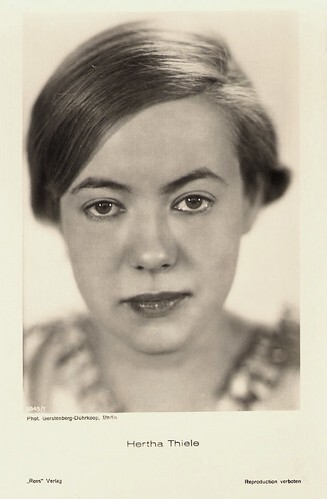
German postcard by Ross Verlag, no. 6845/1, 1931-1932. Photo: Gerstenberg-Dührkoop, Berlin.
For a brief period during the Weimar Republic, Hertha Thiele (1908 -1984) appeared in several controversial stage plays and films. She is best known for playing a 14-year-old schoolgirl in love with her female teacher in the ground-breaking Mädchen in Uniform/Girls in Uniform (1931). She received thousands of fan letters - mostly from women. Decades later, Thiele became a well-known film and television actress in East Germany.
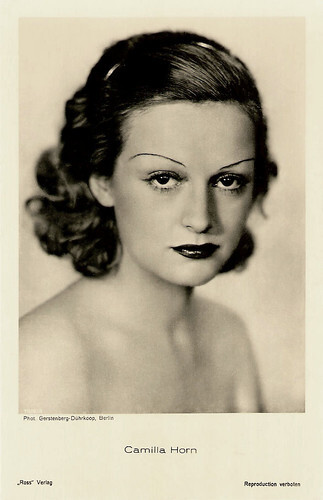
German postcard by Ross Verlag, no. 7916/2, 1932-1933. Photo: Gerstenberg-Dührkoop, Berlin.
Ethereally blonde Camilla Horn (1903-1996) was a German dancer and film star. Her breakthrough role was Gretchen in the silent film classic Faust (Friedrich Wilhelm Murnau, 1926). She also starred in some Hollywood films of the late 1920s and a few British and Italian productions.
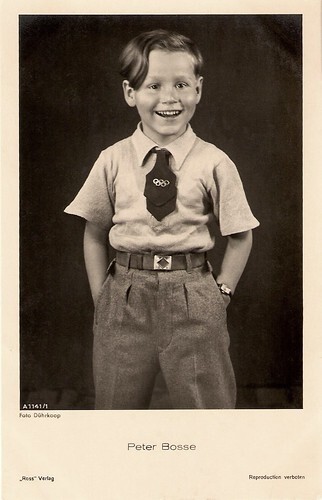
German Postcard by Ross Verlag, no. A 1276/1, 1937-1938. Photo: Dührkoop.
Actor, presenter and journalist Peter Bosse (1931-2018) was a popular child star of the German cinema in the 1930s. The boy with his cheeky face made 28 films.
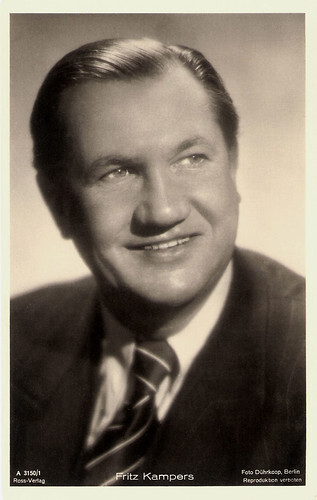
German postcard by Ross Verlag, no. A 3150/1, 1941-1944. Photo: Dührkoop, Berlin.
German actor and director Fritz Kampers (1891-1950) was a solidly built Bavarian character actor. In films from 1913, he was much in demand during the 1920s and 1930s. Kampers was often cast as robust or comic military types, or laconic, but good-hearted rustics in mountaineering or 'Heimat' films. He appeared in more than 260 films.
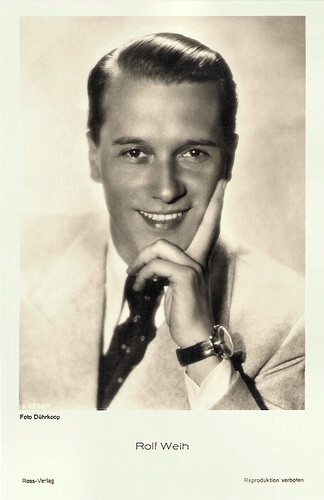
German postcard by Ross-Verlag, no. A 3586/1, 1941-1944. Photo: Dührkoop.
Rolf Weih (1906–1969) was a German film actor, who played supporting parts in many comedies and musicals of the 1930s and 1940s. After the war, he appeared in numerous Heimat films in West Germany.
Stars depicted in their own homes
Rudolf Dührkoop celebrated his 60th birthday on 1 August 1908 and two months later the studio celebrated its 25th anniversary. Dührkoop was presented with a gold medal from Duke Carl Theodor in Bavaria and the Silver Crown Medal from the Saxon Photographers' Association. In 1918, Rudolf Dührkoop died in Hamburg, aged 69.
Minya Diez-Dührkoop continued the company after the death of her father. She made many sepia-tinted portrait photos of artists such as the painters Max Liebermann, Franz Radziwill, Emil Nolde and Max Pechstein and the Hamburg dancers Lavinia Schulz (1896-1924) and Walter Holdt (1899-1924). Dance poses of Schulz and Holdt in expressionist costumes they made themselves were photographed in the Dührkoop studio in variations from the front and from behind, with different backgrounds and different costumes. The domain of contemporary dance must have inspired Minya Diéz-Dührkoop photographically and must have been of particular concern to her, as there are further images in Der künstlerische Tanz unserer Zeit (1928).
She also continued to depict the actors of silent German cinema like film diva Henny Porten . The stars were often depicted in their own homes, without the scenery or props commonly used at the time. In one article, published in the journal Deutsche Kunst und Dekoration, the Dührkoop studio was described as “radical” with a “determined striving towards the future”.
In 1926, Minya remarried. Her second husband was Fritz Karl Gustav Schulz. Minya Dührkoop died in 1929 in Hamburg. Fritz Karl Gustav Schulz continued to run the studio after his wife's sudden death. In the early 1930s, the company was called Gerstenberg-Dührkoop. The studio continued to make portraits of German film actors
From 1935, Antonio Machado, a long-time employee, was the owner of the "Dührkoop Werkstätten". In the postwar years, the name Dührkoop was used again for film star photos made for the new Ufa, but also for the Defa in East Germany. When the Dührkoop studio stopped to exist is unclear.
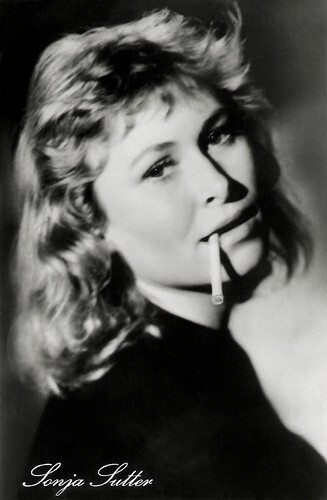
German postcard by VEB Progress Film-Vertrieb, no. 661, 1958. Photo: DEFA / Dührkoop. Publicity still for Lissy (Konrad Wolf, 1957).
German film actress Sonja Sutter (1931–2017) was one of the few actors who was allowed to appear in productions in both East and West Germany. She is remembered for DEFA films like Lissy (1957), her role as Fraulein Rottenmeier in the German TV series Heidi (1978) and for several roles in the TV series Derrick (1983-1998).
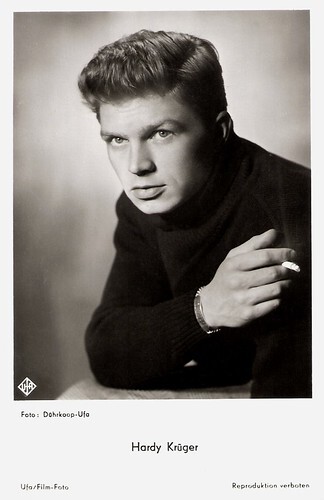
German postcard by Ufa, Berlin-Tempelhof, no. FK 3058. Photo: Dührkoop / Ufa.
German actor and writer Hardy Krüger (1928-2022) was a blond heartthrob in the 1950s. He acted in numerous European movies and also in classic American films.
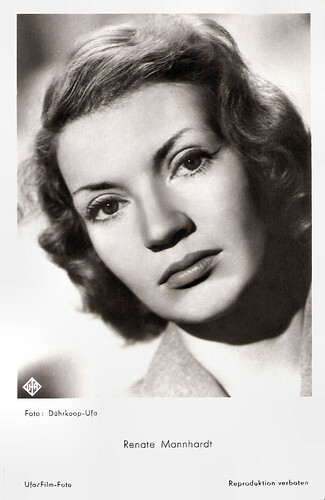
West German postcard by Ufa/Film-Foto, Berlin-Tempelhof, no. FK 3327. Photo: Dührkoop / Ufa.
Renate Mannhardt (1920-2013) was a German supporting actress of the 1950s. She was known for such films as Peter Lorre's Der Verlorene (1951), Die große Schuld/The great debt (1953) and Roberto Rossellini's Non credo più all'amore (La paura)/Fear (1954).
>
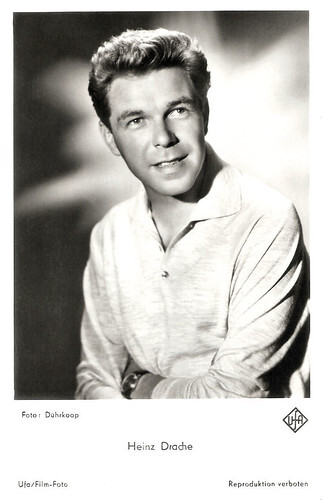
West German postcard by Ufa/Film-Foto, Berlin-Tempelhof, no. FK 3994. Photo: Dührkoop.
Heinz Drache (1923-2002) was the most in-vogue screen cop of post-war German cinema. He first established his reputation in the role of the charismatic Inspector Yates in Francis Durbridge's TV miniseries Das Halstuch (1962) and in the same vein he apprehended villains in a series of Edgar Wallace Krimis such as Der Zinker/The Squeaker (1963). He appeared in 42 films between 1953 and 2002.
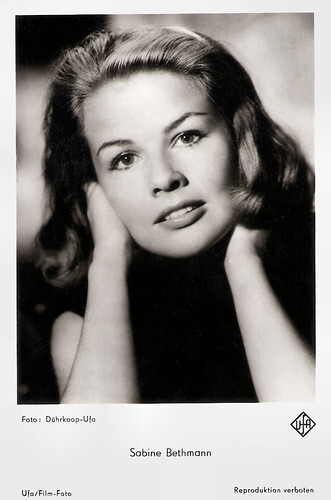
German postcard by Ufa, Berlin-Tempelhof, no. FK 4230. Photo: Dührkoop / Ufa.
German film actress Sabine Bethmann (1931) is best known for Fritz Langs’s Der Tiger von Eschnapur (1959) and the sequel Das Indische Grabmal (1959), together known as 'Fritz Lang's Indian Epic'.
Sources: Viktoria Krieger (Liebermann Villa), MKG Collection, Wikipedia (Dutch and German).

German postcard by Meissner & Buch, Leipzig. Photo: Rud. Dührkoop.
Sturdy and blond Henny Porten (1890-1960) was one of Germany's most important and popular film actresses of silent cinema. She became the quintessence of German womanhood, ladylike yet kindhearted and a not a little petit bourgeois. She was also the producer of many of her films.

German postcard by Photochemie, Berlin, no. K. 1552. Photo: Rudolph Dührkoop, Berlin.
Actress and singer Else Berna appeared in 13 silent German films between 1917 and 1924.

German postcard by Verlag Hermann Leiser, Berlin-Wilm., no. 5233. Photo: R. Dührkoop.
Paul Heidemann (1884-1968) was a German stage and screen actor, film director and film producer. He was famous for his comical parts.

German postcard by Ross Verlag, Berlin, no. 306/2, 1919-1924. Photo: Rudolf Dührkoop.
Viggo Larsen (1880-1957) was a Danish actor, director, scriptwriter and producer. He was one of the pioneers in film history. With Wanda Treumann he directed and produced many German films of the 1910s.

German postcard by Ross Verlag, Berlin, no. 385/1, 1919-1924. Photo: Rudolph Dührkoop.
German actor Charles Willy Kayser (1881-1942) had a remarkable career in the silent cinema. However, today he is little known, while many of his films are considered lost now and there is little information about his work.
Rudolf Dührkoop
Hamburg-based photographer Rudolf Dührkoop (1848-1918) made portrait photos and also took artistic photographs in the style of Pictorialism. Rudolf Johannes Dührkoop was born in 1848, the son of carpenter Christian Friederich Dührkoop and Johanna Friederica Emile. When the Franco-Prussian War broke out in 1870, Dührkoop volunteered to join Infantry Regiment No. 76 and was sent to Paris as an ordinary soldier after the capitulation. In 1872, he returned home, went into business and married Maria Louise Caroline Matzen, with whom he had two daughters, Hanna Maria Theresia, born in 1872, and Julie Wilhelmine, born in 1874.
Dührkoop first worked as a railway employee and then as a merchant. It was during this time that he became interested in photography. Dührkoop acquired the necessary knowledge over the years and familiarised himself with the necessary photographic processes and optics. In 1882, he published his first photograph in Photographisches Wochenblatt, the magazine of the Photographischer Verein zu Berlin. At the end of 1882, Dührkoop applied to the Hamburg Chamber of Commerce for a photographer's licence, which was granted in January 1883.
In 1883, he opened a studio at Große Bäckerstraße 26 in Hamburg and effectively became a professional photographer without any training. Dührkoop began his professional career by making 'Cartes-de-Visite', a kind of business cards with small photographs. In addition, he mainly took portrait photos. He quickly gained success. Just six months after opening his studio, he moved to Hopfenmarkt. He was often asked to photograph prominent German personalities and joined the leading 'Deutschen Photographen-Verein' in 1886.
In 1888, Dührkoop moved into a studio in Ferdinandstraße and two years later, he opened an additional studio in Altona. Over the years, Dührkoop began to take reportage photographs. Outside his studio, he photographed, among other things, a celebration of the 25th anniversary of the 76th Regiment on the Heiligengeistfeld in 1891 and a festive scene on the Hopfenmarkt in 1892 on the occasion of a 50-year celebration to commemorate the outbreak of the Hamburg fire. He showed artistic aspirations and in 1898 he held his first exhibition, with a series of pictorialist portraits of his daughter Minya. From then on, his fame rose all over Germany and later internationally. He opened another studio in Berlin, published in leading photographic magazines such as Die Kunst in der Photographie and also wrote articles on portrait photography.
In 1904, he participated in the Louisiana Purchase Exposition in Saint Louis, where he came into contact with well-known pictorialist art photographers such as Gertrude Käsebier. In 1905, he became the first German member of the prestigious English Royal Photographic Society and in 1906 of the pictorialist photography society Linked Ring. At the time, photographic societies organised exhibitions of photographic works by their members and invited photographers. At regular meetings, the members informed themselves about the latest developments. At such meetings, Dührkoop spoke, for example, about the experiences and successes of his trip to America in 1904. In addition to his artistic work, Rudolf Dührkoop always remained active as a portrait photographer and captured a large number of well-known German personalities on film during his career.

German postcard by Ross Verlag, no. 3465/2, 1928-1929. Photo: Atelier Dührkoop, Berlin.
At the age of 18, German actor Werner Fuetterer (1907-1991) was discovered to play the young lover in a series of silent films. For more than four decades he went on to work as a supporting actor in nearly 100 films.

German postcard by Ross Verlag, no. 4032/1, 1929-1930. Photo: Atelier Dührkoop, Berlin.
Ruth Weyher (1901-1983) was a German actress of the silent cinema.

German postcard by Ross Verlag, no. 4237/1, 1929-1930. Photo: Atelier Dührkoop, Berlin.
Hans Stüwe (1901-1976) was a German singer and opera director. From 1926 on he was also a big film star in Germany. Four times he was the film partner of Ufa diva Zarah Leander.

German collectors card by Salem Zigaretten in the series Bunte Filmbilder, no. 269 (in a series of 275). Photo: Dührkoop / Ross Verlag.
Dutch-German actress Ery Bos (1910-2005) had a short but productive film career in the early German sound film. In only three years, from 1932 to 1934, she took part in a dozen films.

German cigarette card by Ross Verlag in the 'Künstler im Film' series for Zigarettenfabrik Monopol, Dresden, Serie 1, image 115 (of 200). Photo: Dührkoop.
Sexy German dancer and film actress La Jana (1905-1940) was the most popular showgirl in Berlin in the 1930s. She appeared in 25 European films, often dancing in exotic costumes. In 1940, she suddenly died of pneumonia and pleurisy.
Much more than a simple assistant
In 1887, Rudolf Dührkoop made his then 14-year-old daughter Julie Wilhelmine, known as Minya, his studio assistant. Minya Dührkoop was trained as an independent employee and was to become much more than a simple assistant in the years to come. Father and daughter ran the business together. In 1894, Minya married the photographer Luis Diéz Vazquez from Málaga. Nothing is known about any professional collaboration between the couple. When the marriage ended in divorce in 1901, Minya Diéz kept her married name.
Minya and Rudolf Dührkoop were able to assert themselves through the high artistic quality of their photographic work. In addition, the continuous cultivation and expansion of their artistic network was crucial to their success. In 1901, Minya and Rudolf Dührkoop embarked on their first trip to England. This was followed by trips to America in 1904/1905 to visit exhibitions and organise their own exhibitions, as well as to cultivate contacts with other photographers.
In September 1906, Minya Diéz-Dührkoop became a partner of "Rudolf Dührkoop." Rudolf left his daughter the newly rented Hamburg studio at Jungfernstieg 34 in the Heine-Haus and she managed the studio from this point onwards. Rudolf Dührkoop left Hamburg to open and run a "Werkstatt für künstlerische Camera-Bildnisse" and "Neuzeitliche Kamerabildnisse" in Berlin at Unter den Linden 10 in December 1906.
Minya Diéz-Dührkoop collected contemporary art. For example, she owned a painting by the painter Alma del Banco. She moved in artistic circles in Hamburg and numerous writers and artists frequented her studio at Jungfernstieg 34. In 1910, she became a passive member of the Expressionist artists' association "Brücke" and cultivated contacts with writers such as Richard Dehmel and his wife Ida and visual artists such as Max Pechstein, Franz Radziwill and Karl Schmidt-Rottluff
Encounters overseas also shaped her work. A highlight in Minya Diéz-Dührkoop's artistic and social life was the trip to the USA in 1911, which took place at the invitation of the Photographers Association of America. George Eastman had his portrait taken by Diéz-Dührkoop and there was also a professional exchange with the Swiss photographer Helmar Lerski in the USA. Minya and Rudolf Dührkoop's international fame grew steadily through various trips including trips to England in 1901 and 1908 to meet famous photographers such as Emil Otto Hoppé and Alvin Langdon Coburn. At that time, they were the only professional photographers from Germany to be accepted into the elite circle of the Brotherhood of the Linked Ring, otherwise only amateurs were admitted, who at the time had the higher artistic prestige.

German postcard by Ross Verlag, no. 6845/1, 1931-1932. Photo: Gerstenberg-Dührkoop, Berlin.
For a brief period during the Weimar Republic, Hertha Thiele (1908 -1984) appeared in several controversial stage plays and films. She is best known for playing a 14-year-old schoolgirl in love with her female teacher in the ground-breaking Mädchen in Uniform/Girls in Uniform (1931). She received thousands of fan letters - mostly from women. Decades later, Thiele became a well-known film and television actress in East Germany.

German postcard by Ross Verlag, no. 7916/2, 1932-1933. Photo: Gerstenberg-Dührkoop, Berlin.
Ethereally blonde Camilla Horn (1903-1996) was a German dancer and film star. Her breakthrough role was Gretchen in the silent film classic Faust (Friedrich Wilhelm Murnau, 1926). She also starred in some Hollywood films of the late 1920s and a few British and Italian productions.

German Postcard by Ross Verlag, no. A 1276/1, 1937-1938. Photo: Dührkoop.
Actor, presenter and journalist Peter Bosse (1931-2018) was a popular child star of the German cinema in the 1930s. The boy with his cheeky face made 28 films.

German postcard by Ross Verlag, no. A 3150/1, 1941-1944. Photo: Dührkoop, Berlin.
German actor and director Fritz Kampers (1891-1950) was a solidly built Bavarian character actor. In films from 1913, he was much in demand during the 1920s and 1930s. Kampers was often cast as robust or comic military types, or laconic, but good-hearted rustics in mountaineering or 'Heimat' films. He appeared in more than 260 films.

German postcard by Ross-Verlag, no. A 3586/1, 1941-1944. Photo: Dührkoop.
Rolf Weih (1906–1969) was a German film actor, who played supporting parts in many comedies and musicals of the 1930s and 1940s. After the war, he appeared in numerous Heimat films in West Germany.
Stars depicted in their own homes
Rudolf Dührkoop celebrated his 60th birthday on 1 August 1908 and two months later the studio celebrated its 25th anniversary. Dührkoop was presented with a gold medal from Duke Carl Theodor in Bavaria and the Silver Crown Medal from the Saxon Photographers' Association. In 1918, Rudolf Dührkoop died in Hamburg, aged 69.
Minya Diez-Dührkoop continued the company after the death of her father. She made many sepia-tinted portrait photos of artists such as the painters Max Liebermann, Franz Radziwill, Emil Nolde and Max Pechstein and the Hamburg dancers Lavinia Schulz (1896-1924) and Walter Holdt (1899-1924). Dance poses of Schulz and Holdt in expressionist costumes they made themselves were photographed in the Dührkoop studio in variations from the front and from behind, with different backgrounds and different costumes. The domain of contemporary dance must have inspired Minya Diéz-Dührkoop photographically and must have been of particular concern to her, as there are further images in Der künstlerische Tanz unserer Zeit (1928).
She also continued to depict the actors of silent German cinema like film diva Henny Porten . The stars were often depicted in their own homes, without the scenery or props commonly used at the time. In one article, published in the journal Deutsche Kunst und Dekoration, the Dührkoop studio was described as “radical” with a “determined striving towards the future”.
In 1926, Minya remarried. Her second husband was Fritz Karl Gustav Schulz. Minya Dührkoop died in 1929 in Hamburg. Fritz Karl Gustav Schulz continued to run the studio after his wife's sudden death. In the early 1930s, the company was called Gerstenberg-Dührkoop. The studio continued to make portraits of German film actors
From 1935, Antonio Machado, a long-time employee, was the owner of the "Dührkoop Werkstätten". In the postwar years, the name Dührkoop was used again for film star photos made for the new Ufa, but also for the Defa in East Germany. When the Dührkoop studio stopped to exist is unclear.

German postcard by VEB Progress Film-Vertrieb, no. 661, 1958. Photo: DEFA / Dührkoop. Publicity still for Lissy (Konrad Wolf, 1957).
German film actress Sonja Sutter (1931–2017) was one of the few actors who was allowed to appear in productions in both East and West Germany. She is remembered for DEFA films like Lissy (1957), her role as Fraulein Rottenmeier in the German TV series Heidi (1978) and for several roles in the TV series Derrick (1983-1998).

German postcard by Ufa, Berlin-Tempelhof, no. FK 3058. Photo: Dührkoop / Ufa.
German actor and writer Hardy Krüger (1928-2022) was a blond heartthrob in the 1950s. He acted in numerous European movies and also in classic American films.

West German postcard by Ufa/Film-Foto, Berlin-Tempelhof, no. FK 3327. Photo: Dührkoop / Ufa.
Renate Mannhardt (1920-2013) was a German supporting actress of the 1950s. She was known for such films as Peter Lorre's Der Verlorene (1951), Die große Schuld/The great debt (1953) and Roberto Rossellini's Non credo più all'amore (La paura)/Fear (1954).
>

West German postcard by Ufa/Film-Foto, Berlin-Tempelhof, no. FK 3994. Photo: Dührkoop.
Heinz Drache (1923-2002) was the most in-vogue screen cop of post-war German cinema. He first established his reputation in the role of the charismatic Inspector Yates in Francis Durbridge's TV miniseries Das Halstuch (1962) and in the same vein he apprehended villains in a series of Edgar Wallace Krimis such as Der Zinker/The Squeaker (1963). He appeared in 42 films between 1953 and 2002.

German postcard by Ufa, Berlin-Tempelhof, no. FK 4230. Photo: Dührkoop / Ufa.
German film actress Sabine Bethmann (1931) is best known for Fritz Langs’s Der Tiger von Eschnapur (1959) and the sequel Das Indische Grabmal (1959), together known as 'Fritz Lang's Indian Epic'.
Sources: Viktoria Krieger (Liebermann Villa), MKG Collection, Wikipedia (Dutch and German).
Published on April 14, 2024 16:51
April 13, 2024
Ginette Maddie
Ginette Maddie (1898-1980) was a French actress who acted in French and German silent films. Between 1922 and 1958, she appeared in 20 films with such notable directors as Alfred Machin and Julien Duvivier.
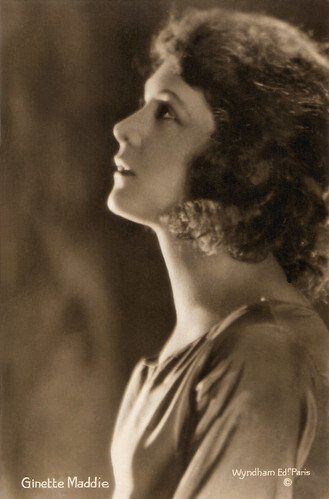
French postcard by Wyndham, Edit., Paris.
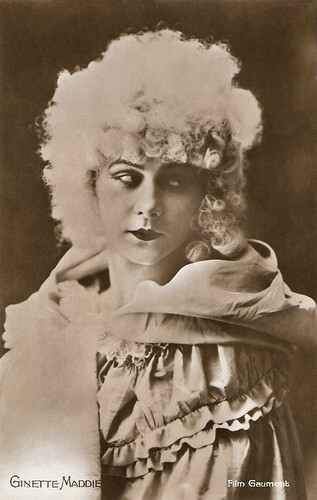
French postcard. Photo: Film Gaumont. Ginette Maddie in Vindicta (Louis Feuillade, 1923).

French postcard by Editions Cinémagazine, no. 107. Photo: Wyndham.
The second woman
Ginette Maddie was born Marcelle Namur in 1898 in Paris, France. She was the daughter of a dressmaker. Officially adopted at the age of seven, she took the name Marcelle Yvonne Gourier.
She started her film career in 1922 opposite Claude Mérelle in Le diamant noir/The Black Diamond (André Hugon, 1922). Her breakthrough was the 5-part serial Vindicta (1923), directed by Louis Feuillade . Maddie was the leading lady in Sarati le terrible/Sarati the Terrible (René Hervil, Louis Mercanton, 1923), La gitanilla (André Hugon, 1924) and the comedy Les héritiers de l'oncle James/The Heirs of Uncle James (Alfred Machin, Henry Wulschleger, 1924).
Other films in which she starred were L'ornière/The Rut (Édouard Chimot, 1924), Le coeur des gueux/The Heart of the Beggars (Alfred Machin, Henry Wulschleger, 1925), and La lueur dans les ténèbres/The Glow in the Darkness (Maurice Charmeroy, 1928) with Edmond van Daele.
Ginette Maddie also often played the second woman in French and German films opposite e.g. Dolly Davis , Madeleine Erickson, Xenia Desni , and Dita Parlo . In the early sound era, Maddie acted in two more films. She appeared opposite singer Damia in Sola/Alone (Henri Diamant-Berger, 1931) and opposite Gina Manès in L'Ensorcellement de Séville (Benito Perojo, 1931).
Years later, two more, small performances followed in 1943 and 1958. Ginette Maddie passed away at the International Hospital of the University of Paris in 1980. She was 82. She is buried in the Pantin cemetery in Paris, in the same vault as the singer Damia .
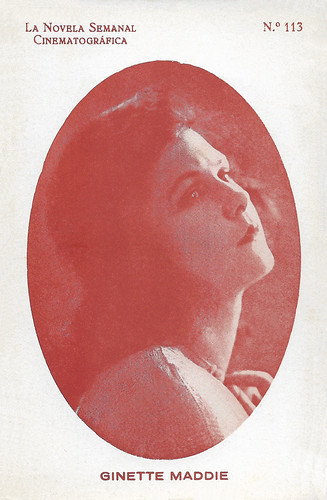
Spanish card by La Novela Semanal Cinematográfica, no. 113.
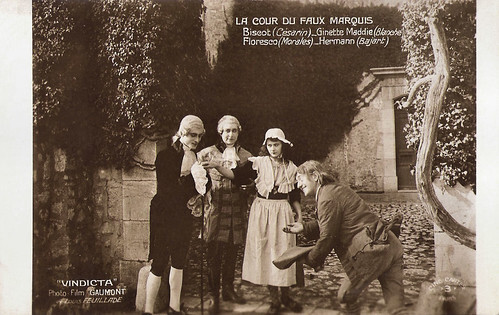
French postcard by Ciné Cartes, Paris, no. 3. Photo: Film Gaumont. Georges Biscot as Césarin at right, Ginette Maddie as Blanche, Michel Floresco as Morales at left and Fernand Hermann as Bajart in Vindicta (Louis Feuillade, 1923). Caption: La cour du faux marquis (The court of the false marquis).
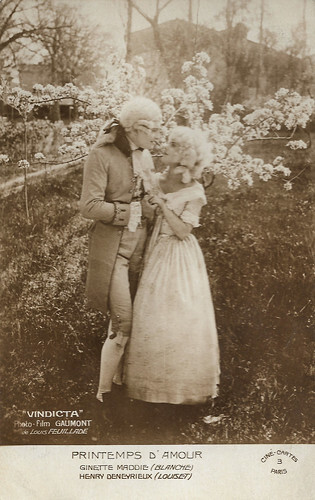
French postcard in the Ciné-cartes series, Paris, no. 3. Photo: Film Gaumont. Ginette Maddie as Blanche and Henry Deneyrieux as Louiset in Vindicta (Louis Feuillade, 1923).
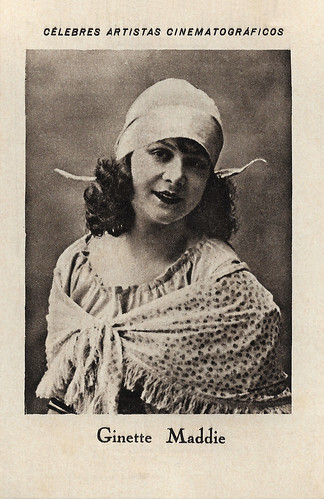
Spanish collector card in the Célebres Artistas Cinematográficos series by Chocolate E. Juncosa, Barcelona, Series D, no 10.
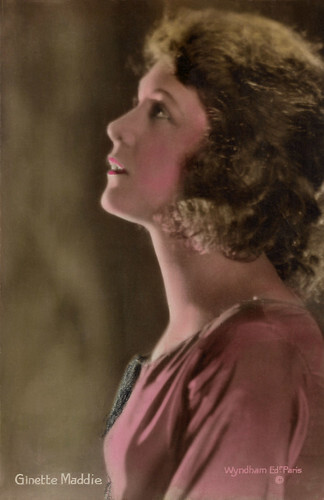
French postcard by Wyndham, Edit., Paris.
Sources: Wikipedia (French and English) and .

French postcard by Wyndham, Edit., Paris.

French postcard. Photo: Film Gaumont. Ginette Maddie in Vindicta (Louis Feuillade, 1923).

French postcard by Editions Cinémagazine, no. 107. Photo: Wyndham.
The second woman
Ginette Maddie was born Marcelle Namur in 1898 in Paris, France. She was the daughter of a dressmaker. Officially adopted at the age of seven, she took the name Marcelle Yvonne Gourier.
She started her film career in 1922 opposite Claude Mérelle in Le diamant noir/The Black Diamond (André Hugon, 1922). Her breakthrough was the 5-part serial Vindicta (1923), directed by Louis Feuillade . Maddie was the leading lady in Sarati le terrible/Sarati the Terrible (René Hervil, Louis Mercanton, 1923), La gitanilla (André Hugon, 1924) and the comedy Les héritiers de l'oncle James/The Heirs of Uncle James (Alfred Machin, Henry Wulschleger, 1924).
Other films in which she starred were L'ornière/The Rut (Édouard Chimot, 1924), Le coeur des gueux/The Heart of the Beggars (Alfred Machin, Henry Wulschleger, 1925), and La lueur dans les ténèbres/The Glow in the Darkness (Maurice Charmeroy, 1928) with Edmond van Daele.
Ginette Maddie also often played the second woman in French and German films opposite e.g. Dolly Davis , Madeleine Erickson, Xenia Desni , and Dita Parlo . In the early sound era, Maddie acted in two more films. She appeared opposite singer Damia in Sola/Alone (Henri Diamant-Berger, 1931) and opposite Gina Manès in L'Ensorcellement de Séville (Benito Perojo, 1931).
Years later, two more, small performances followed in 1943 and 1958. Ginette Maddie passed away at the International Hospital of the University of Paris in 1980. She was 82. She is buried in the Pantin cemetery in Paris, in the same vault as the singer Damia .

Spanish card by La Novela Semanal Cinematográfica, no. 113.

French postcard by Ciné Cartes, Paris, no. 3. Photo: Film Gaumont. Georges Biscot as Césarin at right, Ginette Maddie as Blanche, Michel Floresco as Morales at left and Fernand Hermann as Bajart in Vindicta (Louis Feuillade, 1923). Caption: La cour du faux marquis (The court of the false marquis).

French postcard in the Ciné-cartes series, Paris, no. 3. Photo: Film Gaumont. Ginette Maddie as Blanche and Henry Deneyrieux as Louiset in Vindicta (Louis Feuillade, 1923).

Spanish collector card in the Célebres Artistas Cinematográficos series by Chocolate E. Juncosa, Barcelona, Series D, no 10.

French postcard by Wyndham, Edit., Paris.
Sources: Wikipedia (French and English) and .
Published on April 13, 2024 22:00
April 12, 2024
Jeff Chandler
Ruggedly handsome American actor and singer Jeff Chandler (1918-1961) was best known for his portrayal of legendary Native American Apache chief Cochise in Broken Arrow (1950), for which he was nominated for the Academy Award for Best Supporting Actor. In the 1950s, he was one of Hollywood's most popular film stars and stood out for his imposing stature, his sex appeal, and his early greying hair.
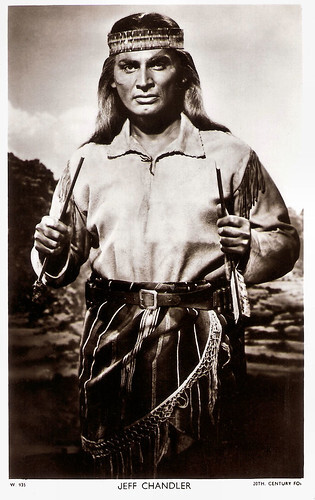
British postcard in the Picturegoer Series, London, no. W. 935. Photo: 20th Century Fox. Jeff Chandler in Broken Arrow (Delmer Daves, 1950).
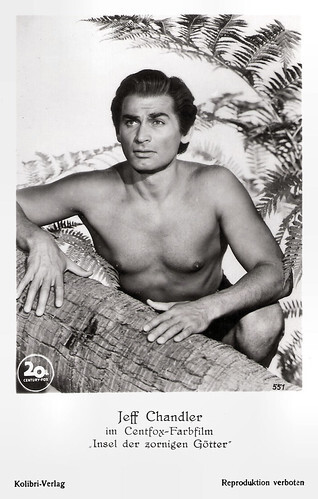
German postcard by Kolibri-Verlag. Photo: 20th Century Fox. Publicity still for Bird of Paradise (Delmer Daves, 1951).
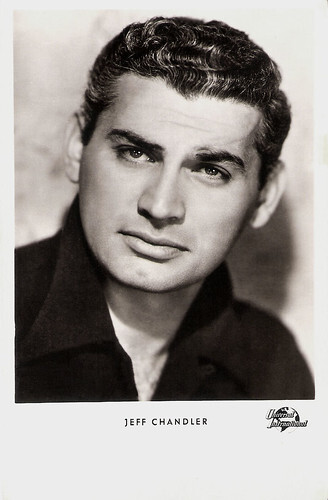
West German postcard by Kunst und Bild, Berlin, no. A 770. Photo: Universal International.
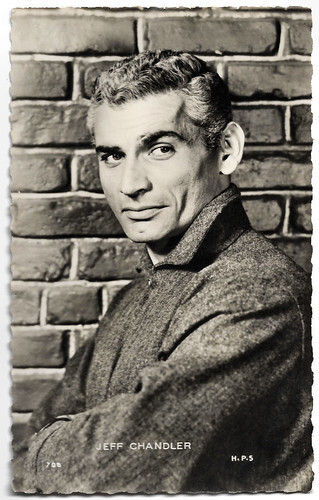
French postcard by Editions P.I., Paris, offered by Les Carbones Korès "Carboplane", no. 708. Photo: H.P.S.
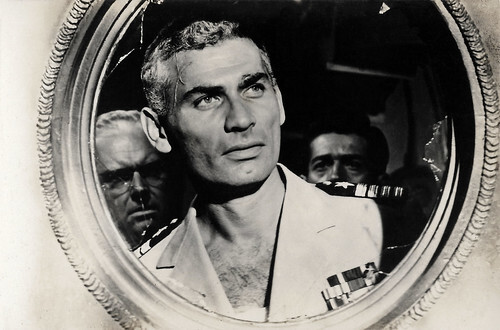
Spanish postcard, no. 574. Photo: Universal. Jeff Chandler in Away All Boats (Joseph Pevney, 1956).
Apache chief Cochise
Jeff Chandler was born Ira Grossel to a Jewish family in Brooklyn, N.Y., in 1918. He was the only child of Anna (née Herman) and Phillip Grossel. He was raised by his mother after his parents separated when he was a child. After attending Erasmus High School, he took acting classes at the Feagin School of Dramatic Art in New York.
He then worked for radio for a while before joining a theatre company on Long Island as an actor and stage manager. He founded his own company, the Shady Lane Playhouse, in Illinois in the summer of 1941. The company toured the Midwest with some success until the United States became involved in World War II. He was active as a soldier in the Aleutians for four years, finishing with the rank of lieutenant.
After the war, Chandler appeared on air in 'Rogue's Gallery 'with Dick Powell , who was impressed by the actor. Powell pressured Columbia to give Chandler his first film role, a one-line uncredited part as a gangster in Johnny O'Clock (Robert Rossen, 1947).
Chandler received more attention playing Eve Arden's love interest on the radio in 'Our Miss Brooks', which debuted in July 1948 and became a massive hit. Chandler's performance in 'Our Miss Brooks' brought him to the attention of Universal executives, who were looking for someone to play an Israeli leader in Sword in the Desert (George Sherman, 1949) starring Dana Andrews . Chandler impressed studio executives so much with his work that Universal signed him to a seven-year contract.
His first film under the arrangement was a supporting role in the Film Noir Abandoned (Joseph M. Newman, 1949). He was best known for his role as Apache chief Cochise in Broken Arrow (Delmer Daves, 1950) with James Stewart and Debra Paget . Broken Arrow became a considerable hit, earning Chandler an Oscar nomination and establishing him as a star. He was the first actor nominated for an Academy Award for portraying an American Indian. He reprised that successful character twice in The Battle at Apache Pass (George Sherman, 1952) and Taza, Son of Cochise (Douglas Sirk, 1954).
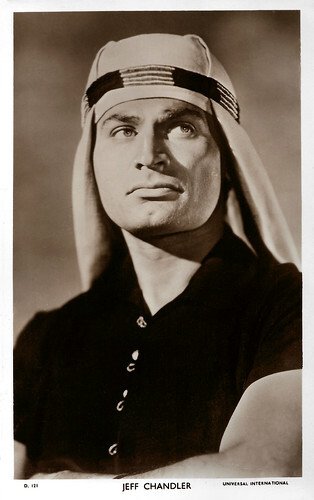
British postcard in the Picturegoer Series, London, no. D. 121. Photo: Universal International. Jeff Chandler in Flame of Araby (Charles Lamont, 1951).
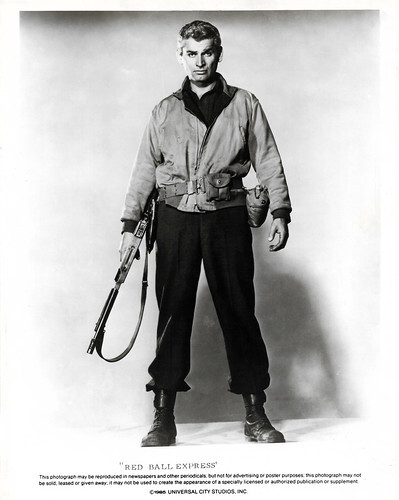
Publicity photo, 1985. Photo: Universal. Jeff Chandler in Red Ball Express (Budd Boetticher, 1952).
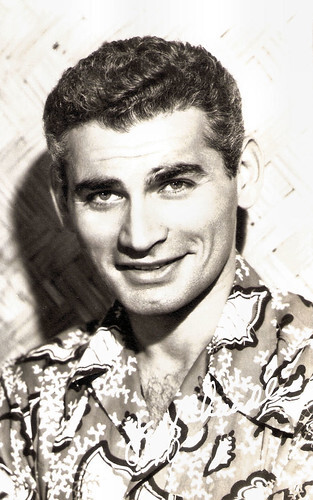
American postcard by Universal International Studios. Sent by mail in 1952.
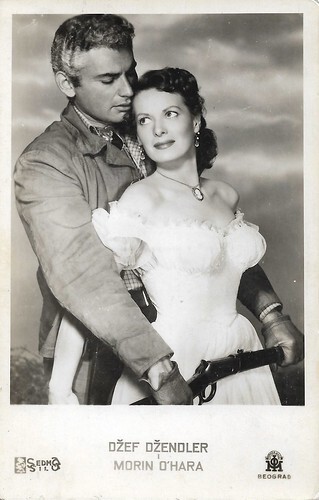
Yugoslavian postcard by Sedma Sila. Photo: IOM, Beograd. Maureen O'Hara and Jeff Chandler in War Arrow (George Sherman, 1953).
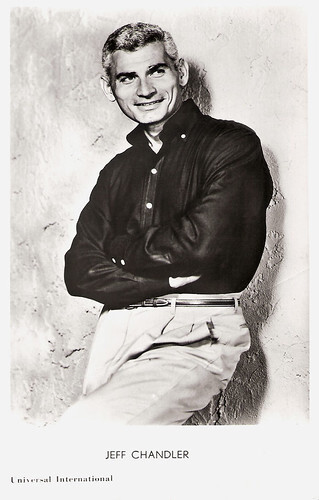
Vintage postcard. Photo: Universal International.
A seven-and-a-half-hour emergency operation
During his short career, Jeff Chandler starred several times in Westerns. He not only played an Indian, but he also stood his ground as a cavalry major as shown in Two Flags West (Robert Wise, 1950) starring Joseph Cotten and War Arrow (George Sherman, 1953) with Maureen O'Hara . Chandler became one of Universal Pictures' more popular male stars of the 1950s.
In addition to his acting in film, he was known for his role in the radio program 'Our Miss Brooks', as Phillip Boynton, her fellow teacher and clueless object of affection, and for his musical recordings. Chandler recorded several successful albums for Liberty Records, wrote music, played violin, and owned Chandler Music, a publishing company.
His other film credits include the Film Noir Deported (Robert Siodmak, 1950) starring Märta Torén , Female on the Beach (Joseph Pevney, 1955) opposite Joan Crawford , and Away All Boats (Joseph Pevney, 1956) with George Nader . In 1957, he left Universal and signed a contract with United Artists. Having long desired to be an executive, he formed his own company, Earlmar Productions.
He was due to star in Operation Petticoat (Blake Edwards, 1959) but became ill and had to pull out. He later formed another production company, August, for which he made The Plunderers (Joseph Pevney, 1960) at Allied Artists. His last film role was that of Brigadier General Frank D. Merrill in Merrill's Marauders (Samuel Fuller, 1962), the last of several World War II films in which he was able to use his military experience. He injured his back while playing baseball with U.S. Army Special Forces soldiers who served as extras in the film.
After undergoing surgery for a spinal disc herniation in May 1961, a major artery was damaged and he haemorrhaged. In a seven-and-a-half-hour emergency operation over and above the original surgery, he was given 55 pints of blood. Another surgery followed where he received an additional 20 pints of blood. He died in the hospital in Culver City, California, in 1961. The cause was a blood infection complicated by pneumonia. He was 42 years old. His death was deemed malpractice and resulted in a large lawsuit and settlement for his children. Jeff Chandler was married from 1946 to 1959 to actress Marjorie Hoshelle with whom he had two daughters. In 1957, he had an affair with Esther Williams while they made a film together, and his wife filed for divorce at the end of the year. Chandler rests in Hillside Memorial Park Cemetery, a Jewish cemetery near Los Angeles.
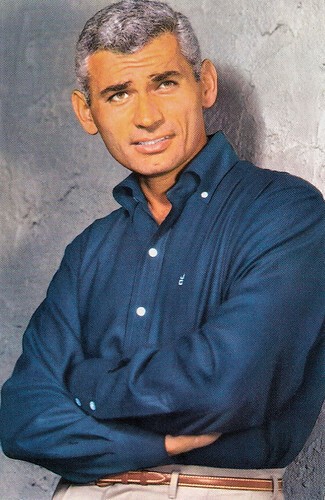
Italian postcard by Rotalfoto, Milano.
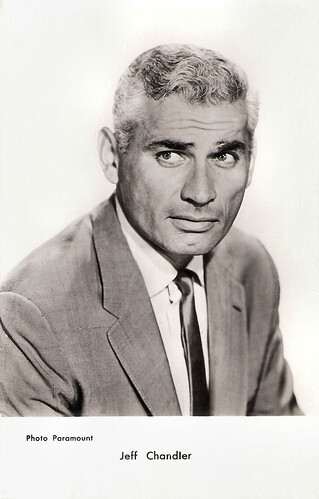
French postcard by Editions P.I., Paris, no. 1071. Photo: Paramount.
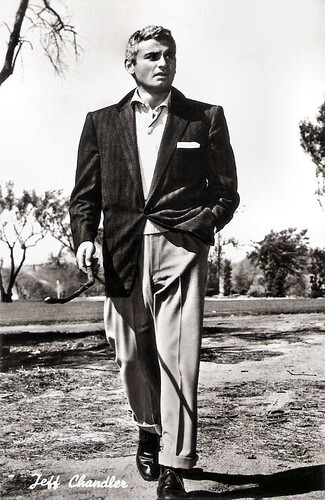
Vintage postcard.
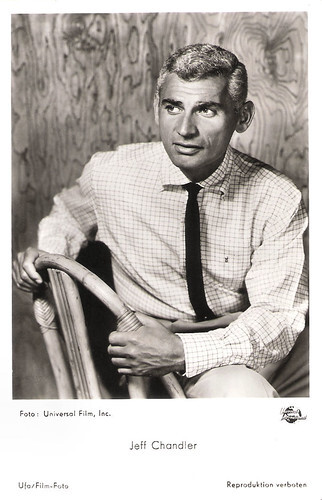
West German postcard by Ufa/Film-Foto, Berlin-Tempelhof, no. FK 3388. Photo: Universal International.
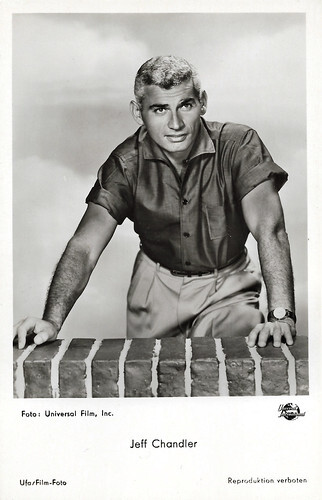
West German postcard by Ufa/Film-Foto, Berlin-Tempelhof, no. FK 23389. Photo: Universal Film.
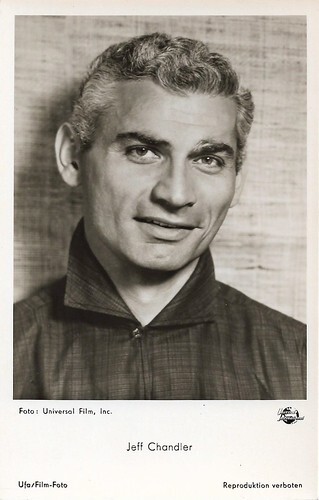
West German postcard by Ufa/Film-Foto. Photo: Universal International.
Sources: William Bjornstad (Find A Grave), (IMDb), Wikipedia (Dutch and English) and .

British postcard in the Picturegoer Series, London, no. W. 935. Photo: 20th Century Fox. Jeff Chandler in Broken Arrow (Delmer Daves, 1950).

German postcard by Kolibri-Verlag. Photo: 20th Century Fox. Publicity still for Bird of Paradise (Delmer Daves, 1951).

West German postcard by Kunst und Bild, Berlin, no. A 770. Photo: Universal International.

French postcard by Editions P.I., Paris, offered by Les Carbones Korès "Carboplane", no. 708. Photo: H.P.S.

Spanish postcard, no. 574. Photo: Universal. Jeff Chandler in Away All Boats (Joseph Pevney, 1956).
Apache chief Cochise
Jeff Chandler was born Ira Grossel to a Jewish family in Brooklyn, N.Y., in 1918. He was the only child of Anna (née Herman) and Phillip Grossel. He was raised by his mother after his parents separated when he was a child. After attending Erasmus High School, he took acting classes at the Feagin School of Dramatic Art in New York.
He then worked for radio for a while before joining a theatre company on Long Island as an actor and stage manager. He founded his own company, the Shady Lane Playhouse, in Illinois in the summer of 1941. The company toured the Midwest with some success until the United States became involved in World War II. He was active as a soldier in the Aleutians for four years, finishing with the rank of lieutenant.
After the war, Chandler appeared on air in 'Rogue's Gallery 'with Dick Powell , who was impressed by the actor. Powell pressured Columbia to give Chandler his first film role, a one-line uncredited part as a gangster in Johnny O'Clock (Robert Rossen, 1947).
Chandler received more attention playing Eve Arden's love interest on the radio in 'Our Miss Brooks', which debuted in July 1948 and became a massive hit. Chandler's performance in 'Our Miss Brooks' brought him to the attention of Universal executives, who were looking for someone to play an Israeli leader in Sword in the Desert (George Sherman, 1949) starring Dana Andrews . Chandler impressed studio executives so much with his work that Universal signed him to a seven-year contract.
His first film under the arrangement was a supporting role in the Film Noir Abandoned (Joseph M. Newman, 1949). He was best known for his role as Apache chief Cochise in Broken Arrow (Delmer Daves, 1950) with James Stewart and Debra Paget . Broken Arrow became a considerable hit, earning Chandler an Oscar nomination and establishing him as a star. He was the first actor nominated for an Academy Award for portraying an American Indian. He reprised that successful character twice in The Battle at Apache Pass (George Sherman, 1952) and Taza, Son of Cochise (Douglas Sirk, 1954).

British postcard in the Picturegoer Series, London, no. D. 121. Photo: Universal International. Jeff Chandler in Flame of Araby (Charles Lamont, 1951).

Publicity photo, 1985. Photo: Universal. Jeff Chandler in Red Ball Express (Budd Boetticher, 1952).

American postcard by Universal International Studios. Sent by mail in 1952.

Yugoslavian postcard by Sedma Sila. Photo: IOM, Beograd. Maureen O'Hara and Jeff Chandler in War Arrow (George Sherman, 1953).

Vintage postcard. Photo: Universal International.
A seven-and-a-half-hour emergency operation
During his short career, Jeff Chandler starred several times in Westerns. He not only played an Indian, but he also stood his ground as a cavalry major as shown in Two Flags West (Robert Wise, 1950) starring Joseph Cotten and War Arrow (George Sherman, 1953) with Maureen O'Hara . Chandler became one of Universal Pictures' more popular male stars of the 1950s.
In addition to his acting in film, he was known for his role in the radio program 'Our Miss Brooks', as Phillip Boynton, her fellow teacher and clueless object of affection, and for his musical recordings. Chandler recorded several successful albums for Liberty Records, wrote music, played violin, and owned Chandler Music, a publishing company.
His other film credits include the Film Noir Deported (Robert Siodmak, 1950) starring Märta Torén , Female on the Beach (Joseph Pevney, 1955) opposite Joan Crawford , and Away All Boats (Joseph Pevney, 1956) with George Nader . In 1957, he left Universal and signed a contract with United Artists. Having long desired to be an executive, he formed his own company, Earlmar Productions.
He was due to star in Operation Petticoat (Blake Edwards, 1959) but became ill and had to pull out. He later formed another production company, August, for which he made The Plunderers (Joseph Pevney, 1960) at Allied Artists. His last film role was that of Brigadier General Frank D. Merrill in Merrill's Marauders (Samuel Fuller, 1962), the last of several World War II films in which he was able to use his military experience. He injured his back while playing baseball with U.S. Army Special Forces soldiers who served as extras in the film.
After undergoing surgery for a spinal disc herniation in May 1961, a major artery was damaged and he haemorrhaged. In a seven-and-a-half-hour emergency operation over and above the original surgery, he was given 55 pints of blood. Another surgery followed where he received an additional 20 pints of blood. He died in the hospital in Culver City, California, in 1961. The cause was a blood infection complicated by pneumonia. He was 42 years old. His death was deemed malpractice and resulted in a large lawsuit and settlement for his children. Jeff Chandler was married from 1946 to 1959 to actress Marjorie Hoshelle with whom he had two daughters. In 1957, he had an affair with Esther Williams while they made a film together, and his wife filed for divorce at the end of the year. Chandler rests in Hillside Memorial Park Cemetery, a Jewish cemetery near Los Angeles.

Italian postcard by Rotalfoto, Milano.

French postcard by Editions P.I., Paris, no. 1071. Photo: Paramount.

Vintage postcard.

West German postcard by Ufa/Film-Foto, Berlin-Tempelhof, no. FK 3388. Photo: Universal International.

West German postcard by Ufa/Film-Foto, Berlin-Tempelhof, no. FK 23389. Photo: Universal Film.

West German postcard by Ufa/Film-Foto. Photo: Universal International.
Sources: William Bjornstad (Find A Grave), (IMDb), Wikipedia (Dutch and English) and .
Published on April 12, 2024 22:00
April 11, 2024
Pierre Étaix
French clown, actor and filmmaker Pierre Étaix (1928-2016) was inspired by Max Linder and Buster Keaton and kept the tradition of slapstick alive. As an actor, assistant director and gag writer, Étaix worked with Jacques Tati, Robert Bresson, Nagisa Oshima, Otar Iosseliani and Jerry Lewis. In the 1960s he made a series of acclaimed short- and feature-length films, many of them co-written by Jean-Claude Carrière. He won an Academy Award for his short film Heureux Anniversaire/Happy Anniversary (1962). Due to a legal dispute with a distribution company, these films were unavailable for three decades.
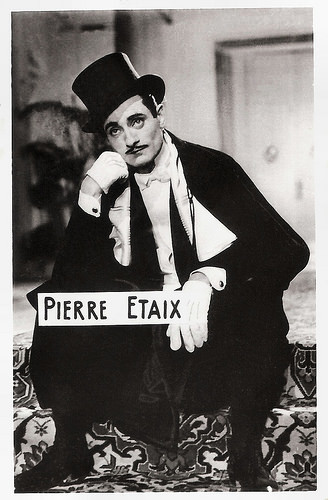
Romanian collectors card. Photo: publicity still for Yoyo/Yo Yo (Pierre Étaix, 1965).
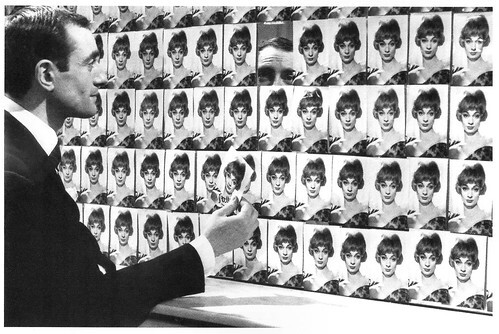
French postcard by Darkstar for Carlotta to promote 'Integrale Pierre Étaix Version restaurée'. Photo: Pierre Étaix and France Arnel in Le Soupirant/The Suitor (Pierre Étaix, 1962).
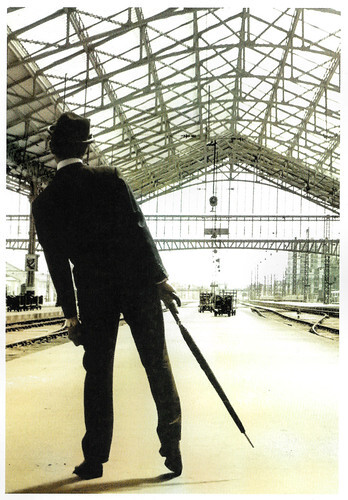
French postcard by Darkstar for Carlotta to promote 'Integrale Pierre Étaix Version restaurée'. Photo: Pierre Etaix in Le grand amour/The Great Love (Pierre Étaix, 1969).
Clucking to a woman who is de-feathering a chicken
Pierre Etaix was born in 1928 in Roanne on the river Loire in central France.
He decided very young to become a clown. Knowing how many skills were needed to fulfil his ambition, he studied the violin and piano, dancing and gymnastics, while teaching himself to play the xylophone, accordion, saxophone, mandolin, trumpet and concertina, as well as learning to become a magician.
He was also trained as a designer and was introduced to the art of stained glass by Theodore Gerard Hanssen. After joining an amateur theatre group in Roanne, Etaix moved to Paris in 1953, working as an illustrator, cartoonist and cabaret performer.
In 1954, he met Jacques Tati and managed to get taken on by his hero’s company, Spectra Films, which had started the lengthy preproduction of Mon Oncle/My Uncle (Jacques Tati, 1958). During the almost four years it took to make the film, Etaix acted as a gag writer, assistant director, storyboardist, gofer and uncredited player. He is seen briefly wheeling a bicycle and, with an imitation of clucking, startling a woman who is de-feathering a chicken. He also created a wonderful poster for the film.
Later, Etaix performed comedy routines at the Parisian music hall Bobino, and at the cabaret Les Trois Baudets in Pigalle. He also appeared in Robert Bresson’s classic Pickpocket (1959), as one of the accomplices of the title character, and in the army comedy Tire-au-flanc/The Army Game (Claude de Givray, François Truffaut, 1961).
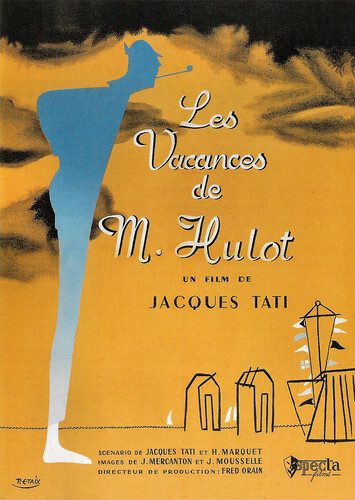
Vintage postcard, no. 6078. Poster design: Pierre Étaix. Film poster for Les Vacances de Monsieur Hulot/Mr. Hulot's Holiday (Jacques Tati, 1953).
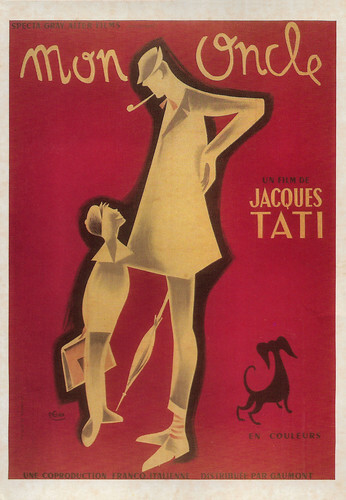
French postcard by Editions Ramsay, no. 170. Poster design: Pierre Étaix / Gaumont. Film poster for Mon Oncle/My Uncle (Jacques Tati, 1958).
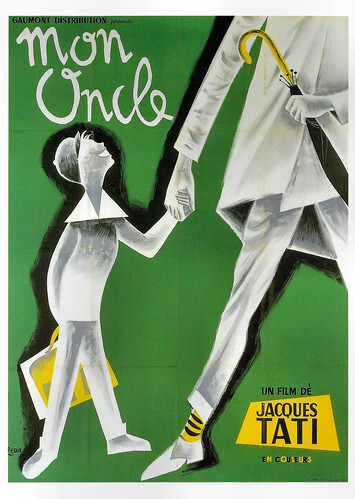
Swiss postcard by CVB Publishers, no. 57383. Poster design: Pierre Étaix. Photo: Collection Cinématèque Suisse, Lausanne. Film poster for Mon Oncle (Jacques Tati, 1958).
A love for the Comedy Kings of Hollywood in the 1920s
In 1960, Pierre Etaix met the then-unknown writer Jean-Claude Carrière, and they became friends. They shared a love for the comedy kings of Hollywood in the 1920s. They first collaborated on ‘novelisations’ of Les Vacances de Monsieur Hulot and Mon Oncle, written by Carrière and illustrated by Etaix.
Then they co-scripted and co-directed two shorts: Insomnie/Rupture (Pierre Etaix, 1961) and Heureux Anniversaire/Happy Anniversary (Pierre Etaix, 1962). The latter, which won the Oscar for Best Short Film, had Etaix as a happily married man meeting a series of obstacles – mainly to do with traffic - as he desperately tries to get home in time for a celebratory dinner with his wife. Etaix, while paying homage to silent film comedy, paradoxically used sound effects as an important element in his work.
His first feature, Le Soupirant/The Suitor (Pierre Etaix, 1963), was a huge success at home and abroad, and established Etaix as ‘the French Buster Keaton ’. Some of the plot – a shy and studious young man has to get married in a hurry – echoes that of Seven Chances (Buster Keaton, 1925), and a scene where Etaix attempts to carry a drunk young woman up to her apartment is almost a carbon copy of a similar one in Keaton’s Spite Marriage (Edward Sedgwick, 1929).
His next film, Yoyo/Yo Yo (Pierre Etaix, 1965), was his masterpiece. He plays a spoilt millionaire who loses everything in the Wall Street crash, then finds his former sweetheart, a circus horse rider, and their son Yoyo, a budding clown. Ronald Bergan in his excellent obituary of Etaix in The Guardian : “This enchanting nostalgic comedy romance, paying tribute to the tone and technique of silent cinema, has no dialogue for the first 30 minutes except for creative sound effects such as the creaking of the vast chateau doors. As both the adult Yoyo and the millionaire, Etaix brought the same control and sense of style to his performance as to his direction.”
Etaix then directed two feature films Tant Qu’on a la Santé/As Long As You’re Healthy (Pierre Etaix, 1966) and Le Grand Amour/The Great Love (Pierre Etaix, 1969), which he co-authored with Jean-Claude Carrière. Tant qu’on a la Santé looked at the absurdity of modern life. In a series of comic set pieces, Etaix played a serious-minded young man harassed wherever he goes – in the city crowds and traffic, at the doctor’s surgery, on a camping site and even on a desert island. Le Grand Amour was Etaix’s first film in colour, about a middle-aged married man who falls for a much younger woman. The wife was played by Annie Fratellini , one of France's few female circus clowns, whom Etaix married in 1969.
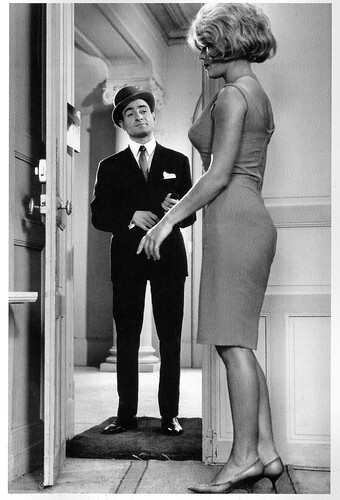
French postcard by Darkstar for Carlotta to promote 'Integrale Pierre Étaix Version restaurée'. Photo: Pierre Etaix in Tant qu'on a la santé/As Long as You've Got Your Health (Pierre Ëtaix, 1966).
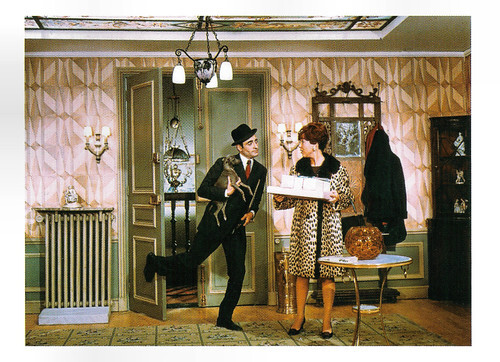
French postcard by Darkstar for Carlotta to promote 'Integrale Pierre Étaix Version restaurée'. Photo: Pierre Etaix and Annie Fratellini in Le grand amour/The Great Love (Pierre Étaix, 1969).
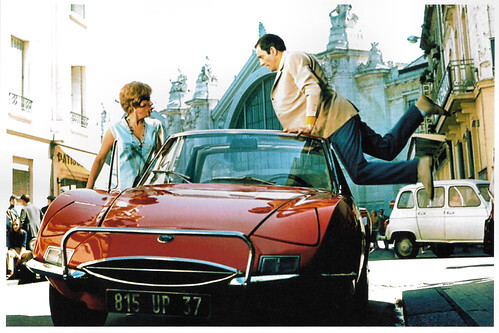
French postcard by Darkstar for Carlotta to promote 'Integrale Pierre Étaix Version restaurée'. Photo: Pierre Etaix and Annie Fratellini in Le grand amour/The Great Love (Pierre Étaix, 1969).
Federico Fellini
Both Pierre Etaix and Annie Fratellini were featured in Federico Fellini ’s semi-documentary I Clowns/The Clowns (1970) about the human fascination with clowns and circuses. In 1974, Fratellini and her husband founded France's first circus school. Etaix’s last feature was the documentary Pays de Cocagne/Land of Milk and Honey (Pierre Etaix, 1971). Ronald Bergan: "A penetrating, rather cruel and satirical look at the French on holiday and their reactions to topical questions put to them by a hidden inquisitor (Etaix). The film, which was edited down from six hours of material to 80 minutes, was both a commercial and a critical failure, and Etaix was seldom seen on the big or small screen after that. In fact, he ‘vanished’ for some years when he and Fratellini joined the touring Pinder Circus as clowns."
In 1972, Jerry Lewis cast the comedian in his unreleased film drama The Day the Clown Cried. Later, Etaix wrote a play, L’Age de Monsieur est Avancé (The Gentleman is Getting On), which was successfully staged in the autumn of 1985 at the Comédie des Champs-Elysées theatre in Paris. Etaix filmed it for television two years later in which he played the lead role opposite Nicole Calfan and Jean Carmet.
Among his later film appearances were roles as a detective in Nagisa Oshima’s Max Mon Amour (1986) and as a friend of Henry Miller (Fred Ward) in Henry and June (Philip Kaufman, 1990). He also appeared in Jardins en Automne/Gardens in Autumn (2006), Chantrapas (2010) and Winter Song (2015), all directed by the Tati and Etaix admirer Otar Iosseliani, the exiled Georgian in Paris. Etaix also played a role in Aki Kaurismäki’s Le Havre/The Harbour (2011).
Because of complex contractual problems, his old films could not be shown for three decades – either in cinemas, on television or on DVD. At last, in 2010, after more than 50,000 people – including Woody Allen , David Lynch, Charlotte Rampling and Jean-Luc Godard – had signed a petition, the films could be restored and rereleased. They were a revelation to a younger generation. In the same year, he toured France with a show inspired by the music hall, Miousik Papillon.
In January 2013, the French government promoted Etaix to the rank of Commandeur des Arts et des Lettres. In June 2013 he received the Grand Prize of the SACD (Society of Authors and Composers of Dramatic) for his entire career. Annie Fratellini died of cancer in 1997. Pierre Etaix is survived by their son, Marc, and by his second wife, Odile (nee Crépin), a former jazz singer. Le Monde reports that the cause of his death was an intestinal infection. James Travers at French Films : “The precise, gentle comedy of Pierre Etaix invites not just admiration, but also genuine affection. Sweet but never mawkish, acerbic but never cruel, his films are packed with as much humanity as humour, and will move you as much as they will make you laugh.”
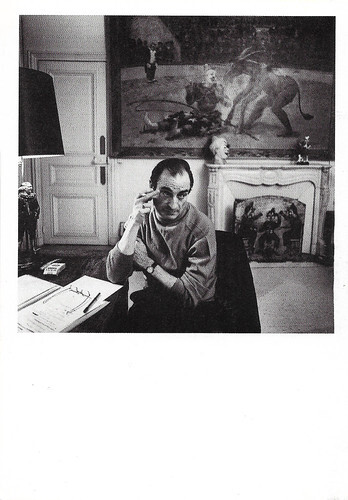
French postcard by Jean-François Claustre / IMP. M.J., 1983. Photo: Jean-François Claustre.
Excerpt from Tant qu’on a la Santé/As Long As You’re Healthy (1966). Source: Janusfilms (YouTube).
American trailer for the 2012-2013 retrospective of the films of Pierre Étaix. Source: Janusfilms (YouTube).
Sources: Ronald Bergan (The Guardian), James Travers (French Films), Ignatiy Vishnevetsky (A.V. Club), Le Monde (French), Wikipedia (French and English), and .

Romanian collectors card. Photo: publicity still for Yoyo/Yo Yo (Pierre Étaix, 1965).

French postcard by Darkstar for Carlotta to promote 'Integrale Pierre Étaix Version restaurée'. Photo: Pierre Étaix and France Arnel in Le Soupirant/The Suitor (Pierre Étaix, 1962).

French postcard by Darkstar for Carlotta to promote 'Integrale Pierre Étaix Version restaurée'. Photo: Pierre Etaix in Le grand amour/The Great Love (Pierre Étaix, 1969).
Clucking to a woman who is de-feathering a chicken
Pierre Etaix was born in 1928 in Roanne on the river Loire in central France.
He decided very young to become a clown. Knowing how many skills were needed to fulfil his ambition, he studied the violin and piano, dancing and gymnastics, while teaching himself to play the xylophone, accordion, saxophone, mandolin, trumpet and concertina, as well as learning to become a magician.
He was also trained as a designer and was introduced to the art of stained glass by Theodore Gerard Hanssen. After joining an amateur theatre group in Roanne, Etaix moved to Paris in 1953, working as an illustrator, cartoonist and cabaret performer.
In 1954, he met Jacques Tati and managed to get taken on by his hero’s company, Spectra Films, which had started the lengthy preproduction of Mon Oncle/My Uncle (Jacques Tati, 1958). During the almost four years it took to make the film, Etaix acted as a gag writer, assistant director, storyboardist, gofer and uncredited player. He is seen briefly wheeling a bicycle and, with an imitation of clucking, startling a woman who is de-feathering a chicken. He also created a wonderful poster for the film.
Later, Etaix performed comedy routines at the Parisian music hall Bobino, and at the cabaret Les Trois Baudets in Pigalle. He also appeared in Robert Bresson’s classic Pickpocket (1959), as one of the accomplices of the title character, and in the army comedy Tire-au-flanc/The Army Game (Claude de Givray, François Truffaut, 1961).

Vintage postcard, no. 6078. Poster design: Pierre Étaix. Film poster for Les Vacances de Monsieur Hulot/Mr. Hulot's Holiday (Jacques Tati, 1953).

French postcard by Editions Ramsay, no. 170. Poster design: Pierre Étaix / Gaumont. Film poster for Mon Oncle/My Uncle (Jacques Tati, 1958).

Swiss postcard by CVB Publishers, no. 57383. Poster design: Pierre Étaix. Photo: Collection Cinématèque Suisse, Lausanne. Film poster for Mon Oncle (Jacques Tati, 1958).
A love for the Comedy Kings of Hollywood in the 1920s
In 1960, Pierre Etaix met the then-unknown writer Jean-Claude Carrière, and they became friends. They shared a love for the comedy kings of Hollywood in the 1920s. They first collaborated on ‘novelisations’ of Les Vacances de Monsieur Hulot and Mon Oncle, written by Carrière and illustrated by Etaix.
Then they co-scripted and co-directed two shorts: Insomnie/Rupture (Pierre Etaix, 1961) and Heureux Anniversaire/Happy Anniversary (Pierre Etaix, 1962). The latter, which won the Oscar for Best Short Film, had Etaix as a happily married man meeting a series of obstacles – mainly to do with traffic - as he desperately tries to get home in time for a celebratory dinner with his wife. Etaix, while paying homage to silent film comedy, paradoxically used sound effects as an important element in his work.
His first feature, Le Soupirant/The Suitor (Pierre Etaix, 1963), was a huge success at home and abroad, and established Etaix as ‘the French Buster Keaton ’. Some of the plot – a shy and studious young man has to get married in a hurry – echoes that of Seven Chances (Buster Keaton, 1925), and a scene where Etaix attempts to carry a drunk young woman up to her apartment is almost a carbon copy of a similar one in Keaton’s Spite Marriage (Edward Sedgwick, 1929).
His next film, Yoyo/Yo Yo (Pierre Etaix, 1965), was his masterpiece. He plays a spoilt millionaire who loses everything in the Wall Street crash, then finds his former sweetheart, a circus horse rider, and their son Yoyo, a budding clown. Ronald Bergan in his excellent obituary of Etaix in The Guardian : “This enchanting nostalgic comedy romance, paying tribute to the tone and technique of silent cinema, has no dialogue for the first 30 minutes except for creative sound effects such as the creaking of the vast chateau doors. As both the adult Yoyo and the millionaire, Etaix brought the same control and sense of style to his performance as to his direction.”
Etaix then directed two feature films Tant Qu’on a la Santé/As Long As You’re Healthy (Pierre Etaix, 1966) and Le Grand Amour/The Great Love (Pierre Etaix, 1969), which he co-authored with Jean-Claude Carrière. Tant qu’on a la Santé looked at the absurdity of modern life. In a series of comic set pieces, Etaix played a serious-minded young man harassed wherever he goes – in the city crowds and traffic, at the doctor’s surgery, on a camping site and even on a desert island. Le Grand Amour was Etaix’s first film in colour, about a middle-aged married man who falls for a much younger woman. The wife was played by Annie Fratellini , one of France's few female circus clowns, whom Etaix married in 1969.

French postcard by Darkstar for Carlotta to promote 'Integrale Pierre Étaix Version restaurée'. Photo: Pierre Etaix in Tant qu'on a la santé/As Long as You've Got Your Health (Pierre Ëtaix, 1966).

French postcard by Darkstar for Carlotta to promote 'Integrale Pierre Étaix Version restaurée'. Photo: Pierre Etaix and Annie Fratellini in Le grand amour/The Great Love (Pierre Étaix, 1969).

French postcard by Darkstar for Carlotta to promote 'Integrale Pierre Étaix Version restaurée'. Photo: Pierre Etaix and Annie Fratellini in Le grand amour/The Great Love (Pierre Étaix, 1969).
Federico Fellini
Both Pierre Etaix and Annie Fratellini were featured in Federico Fellini ’s semi-documentary I Clowns/The Clowns (1970) about the human fascination with clowns and circuses. In 1974, Fratellini and her husband founded France's first circus school. Etaix’s last feature was the documentary Pays de Cocagne/Land of Milk and Honey (Pierre Etaix, 1971). Ronald Bergan: "A penetrating, rather cruel and satirical look at the French on holiday and their reactions to topical questions put to them by a hidden inquisitor (Etaix). The film, which was edited down from six hours of material to 80 minutes, was both a commercial and a critical failure, and Etaix was seldom seen on the big or small screen after that. In fact, he ‘vanished’ for some years when he and Fratellini joined the touring Pinder Circus as clowns."
In 1972, Jerry Lewis cast the comedian in his unreleased film drama The Day the Clown Cried. Later, Etaix wrote a play, L’Age de Monsieur est Avancé (The Gentleman is Getting On), which was successfully staged in the autumn of 1985 at the Comédie des Champs-Elysées theatre in Paris. Etaix filmed it for television two years later in which he played the lead role opposite Nicole Calfan and Jean Carmet.
Among his later film appearances were roles as a detective in Nagisa Oshima’s Max Mon Amour (1986) and as a friend of Henry Miller (Fred Ward) in Henry and June (Philip Kaufman, 1990). He also appeared in Jardins en Automne/Gardens in Autumn (2006), Chantrapas (2010) and Winter Song (2015), all directed by the Tati and Etaix admirer Otar Iosseliani, the exiled Georgian in Paris. Etaix also played a role in Aki Kaurismäki’s Le Havre/The Harbour (2011).
Because of complex contractual problems, his old films could not be shown for three decades – either in cinemas, on television or on DVD. At last, in 2010, after more than 50,000 people – including Woody Allen , David Lynch, Charlotte Rampling and Jean-Luc Godard – had signed a petition, the films could be restored and rereleased. They were a revelation to a younger generation. In the same year, he toured France with a show inspired by the music hall, Miousik Papillon.
In January 2013, the French government promoted Etaix to the rank of Commandeur des Arts et des Lettres. In June 2013 he received the Grand Prize of the SACD (Society of Authors and Composers of Dramatic) for his entire career. Annie Fratellini died of cancer in 1997. Pierre Etaix is survived by their son, Marc, and by his second wife, Odile (nee Crépin), a former jazz singer. Le Monde reports that the cause of his death was an intestinal infection. James Travers at French Films : “The precise, gentle comedy of Pierre Etaix invites not just admiration, but also genuine affection. Sweet but never mawkish, acerbic but never cruel, his films are packed with as much humanity as humour, and will move you as much as they will make you laugh.”

French postcard by Jean-François Claustre / IMP. M.J., 1983. Photo: Jean-François Claustre.
Excerpt from Tant qu’on a la Santé/As Long As You’re Healthy (1966). Source: Janusfilms (YouTube).
American trailer for the 2012-2013 retrospective of the films of Pierre Étaix. Source: Janusfilms (YouTube).
Sources: Ronald Bergan (The Guardian), James Travers (French Films), Ignatiy Vishnevetsky (A.V. Club), Le Monde (French), Wikipedia (French and English), and .
Published on April 11, 2024 22:00
April 10, 2024
A Knight's Tale (2001)
Heath Ledger played a man pretending to be a knight in A Knight's Tale (2001), written, co-produced and directed by Brian Helgeland. The swashbuckling comedy-drama is full of deliberate anachronisms: set in the 1370s, but with modern pop culture references and classic rock songs on the soundtrack.
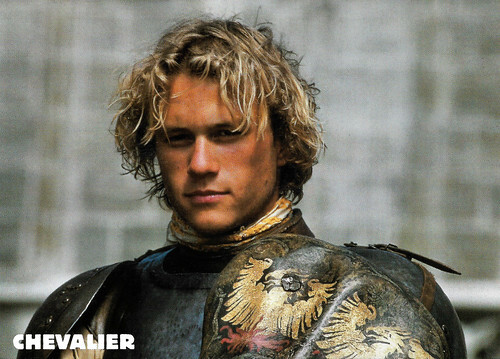
French promotional postcard by Columbia Pictures, 2001. Heath Ledger in A Knight's Tale (Brian Helgeland, 2001). The French film title is Chevalier.
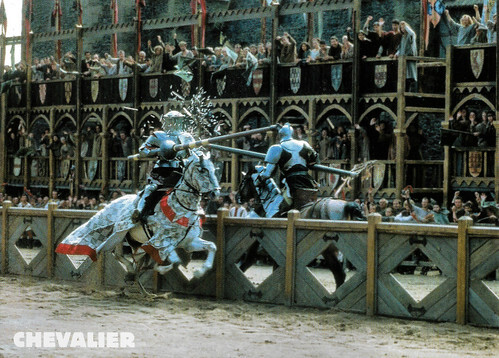
French promotional postcard by Columbia Pictures, 2001. Photo: publicity still for A Knight's Tale (Brian Helgeland, 2001).
The Canterbury Tales
Heath Ledger stars in A Knight's Tale (2001) as William Thatcher, a young squire with a gift for jousting. During a tournament, his master, the old knight Sir Ector, suddenly dies. With one more pass, he could have won the tournament.
Destitute, William wears Sir Ector's armour to impersonate him, taking the prize. After the tournament, William hits the road with his cohorts Roland (Mark Addy) and Wat (Alan Tudyk).
On their journey, they stumble upon a homeless and naked Geoffrey Chaucer (Paul Bettany), a still unknown author who would eventually write 'The Canterbury Tales'. William, lacking an actual title, convinces Chaucer to forge genealogy documents that will pass him off as a knight.
Thatcher then fakes his way into tournaments as 'Sir Ulrich von Liechtenstein' from Gelderland and sets out to prove himself a worthy knight. Eventually, he faces the dreaded Count Adhemar of Anjou (Rufus Sewell) and also woos the maiden Jocelyn (Shannyn Sossamon).
Inspired by 'The Canterbury Tales', as well as the early life of William Marshall (later First Earl of Pembroke), A Knight's Tale (2001) is an eccentric cocktail of rock music, today's lingo and a story set in the middle ages. Baz Luhrmann pulled a similar trick with both Romeo & Juliet (1996). Songs like Queen's 'Rock You' and David Bowie 's 'Golden Years' fit nicely in A Knight's Tale. Note also both The London Eye and The Eiffel Tower in the film!
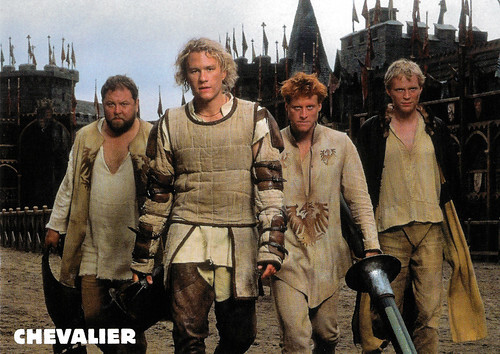
French promotional postcard by Columbia Pictures, 2001. Photo: Heath Ledger, Mark Addy, Alan Tudyk and Paul Bettany in A Knight's Tale (Brian Helgeland, 2001).
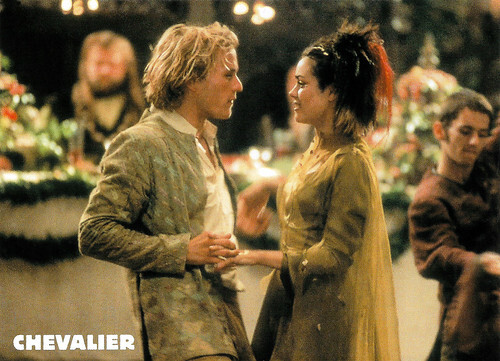
French promotional postcard by Columbia Pictures, 2001. Heath Ledger and Shannyn Sossamon in A Knight's Tale (Brian Helgeland, 2001).
We Will Rock You
More than 20 years after the premiere of A Knight's Tale (2001), director Brian Helgeland's approach still feels fresh, sassy and on point. The entire cast, which was relatively unknown at the time, made the film a masterpiece.
The young Heath Ledger is excellent as the peasant who wants to be a knight. Ledger is surrounded by a good supporting cast of Rufus Sewell, Mark Addy, Shannyn Sossamon and James Purefoy.
The show stealer is Paul Bettany, who went on to play Russell Crowe's friend in both A Beautiful Mind and Master and Commander: The Far Side of the World. Here he plays Geoffrey Chaucer, just at the dawn of his literary career.
Brian Helgeland says in the DVD Special Edition's commentary that he had intended to show what Chaucer might have been doing that inspired him to write 'The Canterbury Tales' during the six months in which Chaucer seems to have gone missing in 1372. At the end of the film, Chaucer champions William's fame and writes his 'Knight's Tale'.
Critic Roger Ebert loved the film: "It is possible, I suppose, to object when the audience at a 15th-century (sic) jousting match begins to sing Queen's 'We Will Rock You' and follows it with the wave. I laughed. I smiled, in fact, all through Brian Helgeland's A Knight's Tale (...) The movie has an innocence and charm that grow on you. It's a reminder of the days before films got so cynical and unrelentingly violent. A Knight's Tale is whimsical, silly and romantic."
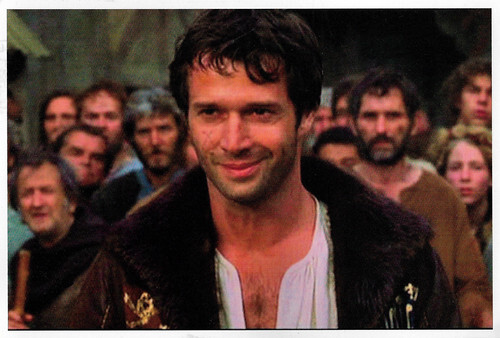
American card. James Purefoy in A Knight's Tale (Brian Helgeland, 2001).
Sources: Roger Ebert (RogerEbert.com), Wikipedia and IMDb.

French promotional postcard by Columbia Pictures, 2001. Heath Ledger in A Knight's Tale (Brian Helgeland, 2001). The French film title is Chevalier.

French promotional postcard by Columbia Pictures, 2001. Photo: publicity still for A Knight's Tale (Brian Helgeland, 2001).
The Canterbury Tales
Heath Ledger stars in A Knight's Tale (2001) as William Thatcher, a young squire with a gift for jousting. During a tournament, his master, the old knight Sir Ector, suddenly dies. With one more pass, he could have won the tournament.
Destitute, William wears Sir Ector's armour to impersonate him, taking the prize. After the tournament, William hits the road with his cohorts Roland (Mark Addy) and Wat (Alan Tudyk).
On their journey, they stumble upon a homeless and naked Geoffrey Chaucer (Paul Bettany), a still unknown author who would eventually write 'The Canterbury Tales'. William, lacking an actual title, convinces Chaucer to forge genealogy documents that will pass him off as a knight.
Thatcher then fakes his way into tournaments as 'Sir Ulrich von Liechtenstein' from Gelderland and sets out to prove himself a worthy knight. Eventually, he faces the dreaded Count Adhemar of Anjou (Rufus Sewell) and also woos the maiden Jocelyn (Shannyn Sossamon).
Inspired by 'The Canterbury Tales', as well as the early life of William Marshall (later First Earl of Pembroke), A Knight's Tale (2001) is an eccentric cocktail of rock music, today's lingo and a story set in the middle ages. Baz Luhrmann pulled a similar trick with both Romeo & Juliet (1996). Songs like Queen's 'Rock You' and David Bowie 's 'Golden Years' fit nicely in A Knight's Tale. Note also both The London Eye and The Eiffel Tower in the film!

French promotional postcard by Columbia Pictures, 2001. Photo: Heath Ledger, Mark Addy, Alan Tudyk and Paul Bettany in A Knight's Tale (Brian Helgeland, 2001).

French promotional postcard by Columbia Pictures, 2001. Heath Ledger and Shannyn Sossamon in A Knight's Tale (Brian Helgeland, 2001).
We Will Rock You
More than 20 years after the premiere of A Knight's Tale (2001), director Brian Helgeland's approach still feels fresh, sassy and on point. The entire cast, which was relatively unknown at the time, made the film a masterpiece.
The young Heath Ledger is excellent as the peasant who wants to be a knight. Ledger is surrounded by a good supporting cast of Rufus Sewell, Mark Addy, Shannyn Sossamon and James Purefoy.
The show stealer is Paul Bettany, who went on to play Russell Crowe's friend in both A Beautiful Mind and Master and Commander: The Far Side of the World. Here he plays Geoffrey Chaucer, just at the dawn of his literary career.
Brian Helgeland says in the DVD Special Edition's commentary that he had intended to show what Chaucer might have been doing that inspired him to write 'The Canterbury Tales' during the six months in which Chaucer seems to have gone missing in 1372. At the end of the film, Chaucer champions William's fame and writes his 'Knight's Tale'.
Critic Roger Ebert loved the film: "It is possible, I suppose, to object when the audience at a 15th-century (sic) jousting match begins to sing Queen's 'We Will Rock You' and follows it with the wave. I laughed. I smiled, in fact, all through Brian Helgeland's A Knight's Tale (...) The movie has an innocence and charm that grow on you. It's a reminder of the days before films got so cynical and unrelentingly violent. A Knight's Tale is whimsical, silly and romantic."

American card. James Purefoy in A Knight's Tale (Brian Helgeland, 2001).
Sources: Roger Ebert (RogerEbert.com), Wikipedia and IMDb.
Published on April 10, 2024 22:00
April 9, 2024
More Förlag Nordisk Konst
Förlag Nordisk Konst published some of the most interesting postcards of the Swedish silent cinema. We love them. Nordisk Konst was a Nordic company, at least it also had a Copenhagen branch besides its branch in Stockholm. Among the Scandinavian postcard publishers, Nordisk did a lot of the film promotion postcards On 9 March 2018, we did a post with 15 sepia Nordisk postcards of Swedish films of the 1910s and 1920s. On 3 January 2022, EFSP presented 15 Nordisk postcards of Hollywood stars including a card of the most legendary director of the American silent cinema. On 8 January 2022 followed a post with 15 Scandinavian stars of the silent era. Jean Ritsema made a list with the postcards by this legendary publisher at Ross Postcards. Ivo Blom searched on Scandinavian sites for more Nordisk Konst postcards. Here are 20 of his new finds.
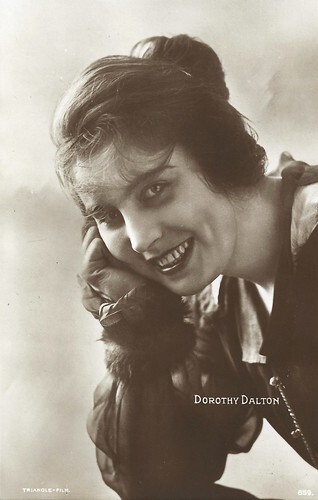
Swedish postcard by Förlag, Nordisk Konst, Stockholm, no. 659. Photo: Apeda (Alexander W. Dreyfoos) / Triangle-Film. Dorothy Dalton .
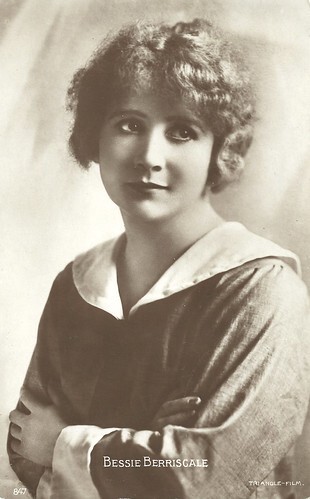
Swedish postcard by Förlag Nordisk Konst, Stockholm, no. 847. Photo: Albert Witzel / Triangle-Film. Bessie Barriscale 's name is misspelt on this card.
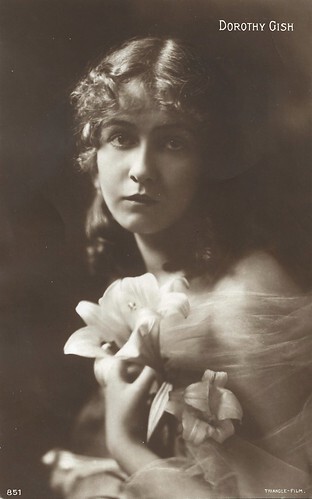
Swedish postcard by Förlag Nordisk Konst, Stockholm, no. 851. Photo: Triangle-Film. Dorothy Gish .
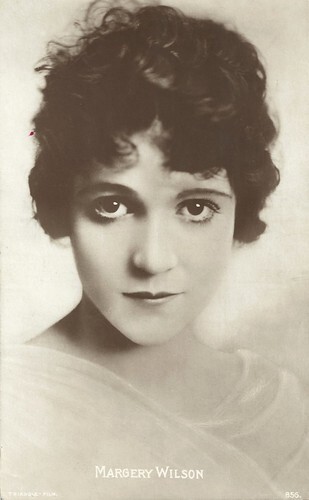
Swedish postcard by Förlag Nordisk Konst, Stockholm, no. 856. Photo: Triangle Film, ca. 1917. Margery Wilson.
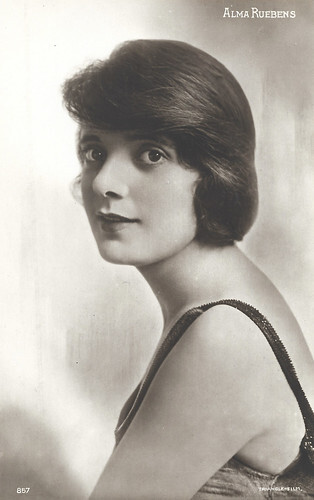
Swedish postcard by Förlag Nordisk Konst, Stockholm, no. 857. Photo: Triangle-Film. Alma Rubens.
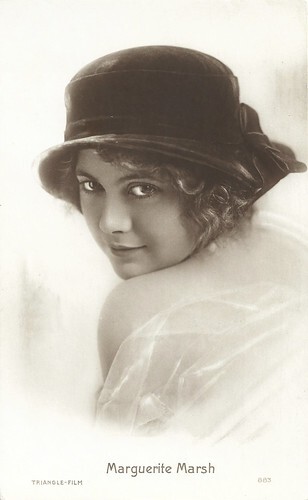
Swedish postcard by Förlag Nordisk Konst, Stockholm, no. 883. Photo: Triangle Film. Marguerite Marsh.
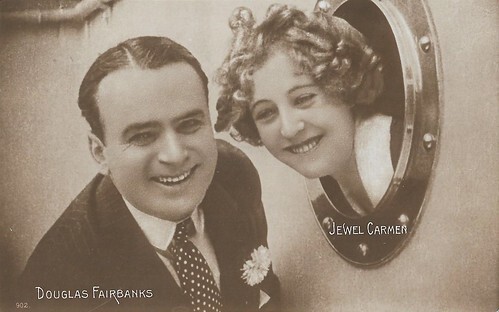
Swedish postcard by Förlag Nordisk Konst, Stockholm, no. 902. Douglas Fairbanks and Jewel Carmen.
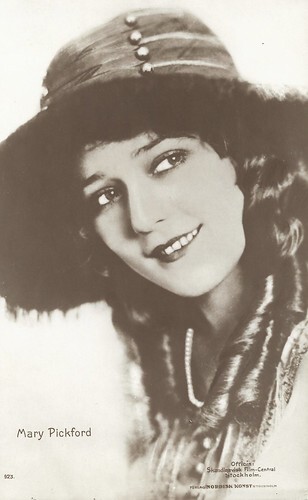
Swedish postcard by Förlag Nordisk Konst, Stockholm, no. 923. Photo: Apeda / Skandinavisk Film-Central, Stockholm. Mary Pickford .
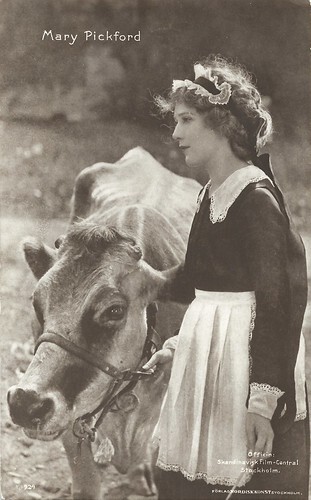
Swedish postcard by Förlag Nordisk Konst, Stockholm, no. 924. Photo: Skandinavisk Film-Central, Stockholm. Mary Pickford in How Could You, Jean? (William Desmond Taylor, 1918).
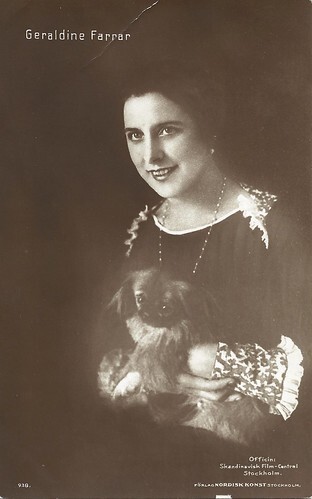
Swedish postcard by Förlag Nordisk Konst, Stockholm, no. 938. Photo: Skandinavisk Film-Central, Stockholm. Geraldine Farrar .
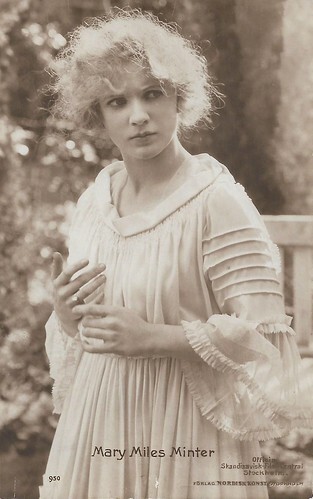
Swedish postcard by Förlag Nordisk Konst, Stockholm, no. 950. Photo: Skandinavisk-Film-Central, Stockholm. Mary Miles Minter .
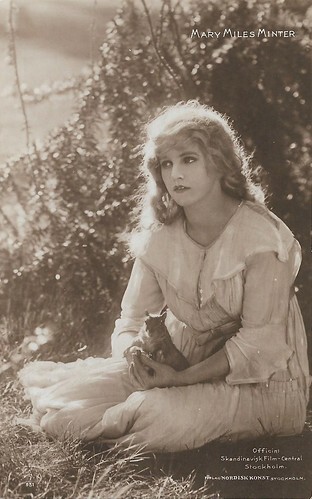
Swedish postcard by Förlag Nordisk Konst, Stockholm, no. 951. Photo: Skandinavisk-Film-Central, Stockholm. Mary Miles Minter .
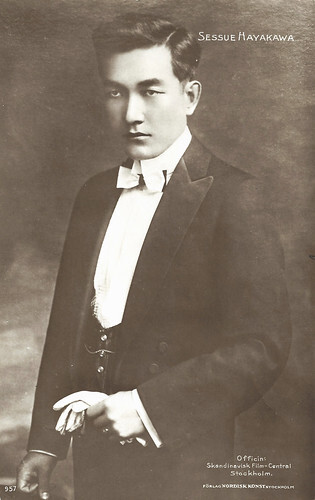
Swedish postcard by Förlag Nordisk Konst, Stockholm, no. 957. Photo: Fred Hartsook / Skandinavisk Film-Central, Stockholm. Sessue Hayakawa .
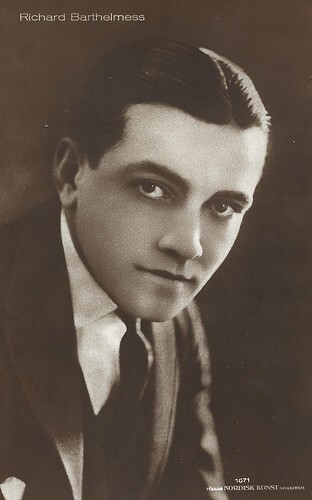
Swedish postcard by Förlag Nordisk Konst, Stockholm, no. 1071. Richard Barthelmess .
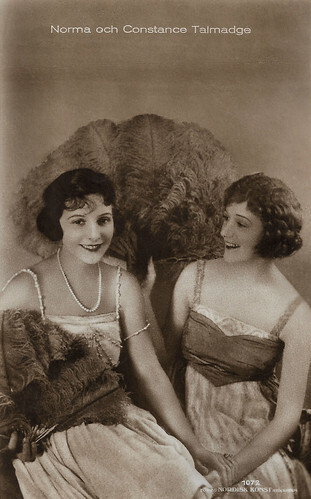
Swedish postcard by Förlag Nordisk Konst, Stockholm, no. 1072. Norma Talmadge and Constance Talmadge .
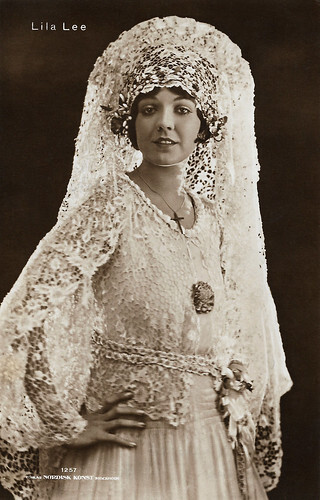
Swedish postcard by Förlag Nordisk Konst, Stockholm, no. 1257. Lila Lee in Blood and Sand (Fred Niblo, Dorothy Arzner, 1922).
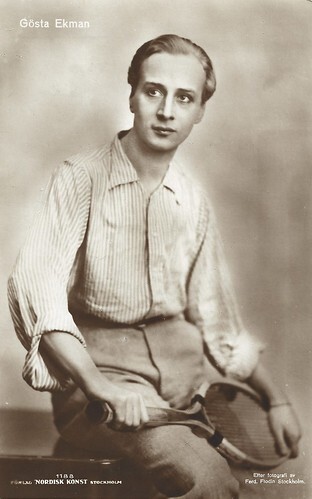
Swedish postcard by Förlag Nordisk Konst, Stockholm, no. 1188. Photo: Ferd. Flodin, Stockholm. Gösta Ekman . Written on the back: 1922.
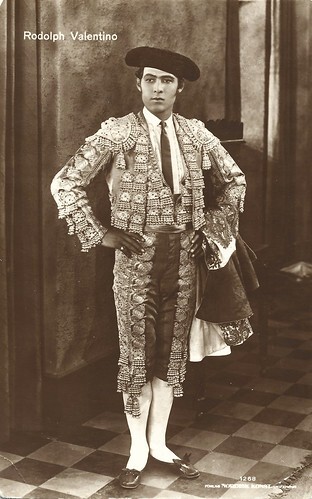
Swedish postcard by Förlag Nordisk Konst, Stockholm, no. 1268. Photo: Paramount. Rudolph Valentino in Blood and Sand (Fred Niblo, 1922).
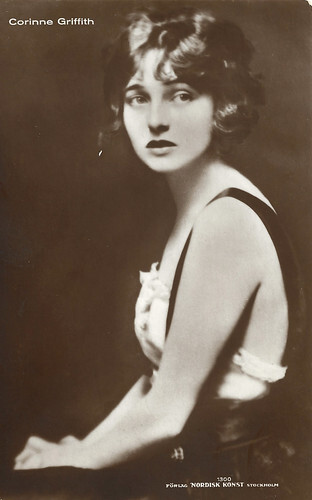
Swedish postcard by Förlag Nordisk Konst, Stockholm, no. 1300. Corinne Griffith .
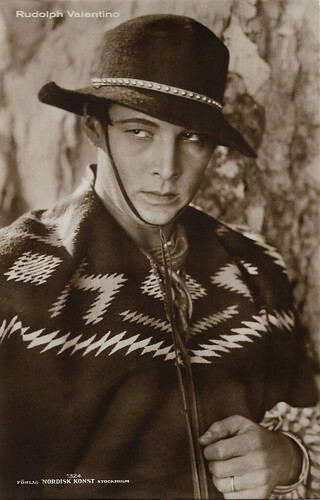
Swedish postcard by Förlag Nordisk Konst, Stockholm, no. 1324. Rudolph Valentino in A Sainted Devil (Joseph Henabery, 1924).
Check out our earlier posts on Förlag Nordisk Konst:
9 March 2018: Nordisk postcards of Swedish films of the 1910s and 1920s.
3 January 2022: 15 Nordisk postcards of Hollywood stars of the silent era.
8 January 2022: 15 Nordisk postcards of Scandinavian stars of the silent era.
And check out the Nordisk Förlag section at Ross Postcards.

Swedish postcard by Förlag, Nordisk Konst, Stockholm, no. 659. Photo: Apeda (Alexander W. Dreyfoos) / Triangle-Film. Dorothy Dalton .

Swedish postcard by Förlag Nordisk Konst, Stockholm, no. 847. Photo: Albert Witzel / Triangle-Film. Bessie Barriscale 's name is misspelt on this card.

Swedish postcard by Förlag Nordisk Konst, Stockholm, no. 851. Photo: Triangle-Film. Dorothy Gish .

Swedish postcard by Förlag Nordisk Konst, Stockholm, no. 856. Photo: Triangle Film, ca. 1917. Margery Wilson.

Swedish postcard by Förlag Nordisk Konst, Stockholm, no. 857. Photo: Triangle-Film. Alma Rubens.

Swedish postcard by Förlag Nordisk Konst, Stockholm, no. 883. Photo: Triangle Film. Marguerite Marsh.

Swedish postcard by Förlag Nordisk Konst, Stockholm, no. 902. Douglas Fairbanks and Jewel Carmen.

Swedish postcard by Förlag Nordisk Konst, Stockholm, no. 923. Photo: Apeda / Skandinavisk Film-Central, Stockholm. Mary Pickford .

Swedish postcard by Förlag Nordisk Konst, Stockholm, no. 924. Photo: Skandinavisk Film-Central, Stockholm. Mary Pickford in How Could You, Jean? (William Desmond Taylor, 1918).

Swedish postcard by Förlag Nordisk Konst, Stockholm, no. 938. Photo: Skandinavisk Film-Central, Stockholm. Geraldine Farrar .

Swedish postcard by Förlag Nordisk Konst, Stockholm, no. 950. Photo: Skandinavisk-Film-Central, Stockholm. Mary Miles Minter .

Swedish postcard by Förlag Nordisk Konst, Stockholm, no. 951. Photo: Skandinavisk-Film-Central, Stockholm. Mary Miles Minter .

Swedish postcard by Förlag Nordisk Konst, Stockholm, no. 957. Photo: Fred Hartsook / Skandinavisk Film-Central, Stockholm. Sessue Hayakawa .

Swedish postcard by Förlag Nordisk Konst, Stockholm, no. 1071. Richard Barthelmess .

Swedish postcard by Förlag Nordisk Konst, Stockholm, no. 1072. Norma Talmadge and Constance Talmadge .

Swedish postcard by Förlag Nordisk Konst, Stockholm, no. 1257. Lila Lee in Blood and Sand (Fred Niblo, Dorothy Arzner, 1922).

Swedish postcard by Förlag Nordisk Konst, Stockholm, no. 1188. Photo: Ferd. Flodin, Stockholm. Gösta Ekman . Written on the back: 1922.

Swedish postcard by Förlag Nordisk Konst, Stockholm, no. 1268. Photo: Paramount. Rudolph Valentino in Blood and Sand (Fred Niblo, 1922).

Swedish postcard by Förlag Nordisk Konst, Stockholm, no. 1300. Corinne Griffith .

Swedish postcard by Förlag Nordisk Konst, Stockholm, no. 1324. Rudolph Valentino in A Sainted Devil (Joseph Henabery, 1924).
Check out our earlier posts on Förlag Nordisk Konst:
9 March 2018: Nordisk postcards of Swedish films of the 1910s and 1920s.
3 January 2022: 15 Nordisk postcards of Hollywood stars of the silent era.
8 January 2022: 15 Nordisk postcards of Scandinavian stars of the silent era.
And check out the Nordisk Förlag section at Ross Postcards.
Published on April 09, 2024 22:00
April 8, 2024
Audrey Totter
American actress Audrey Totter (1917-2013) often portrayed jilted lovers, bad girls, unfaithful wives, and women with a past. She played her first film role as a 'bad' girl in Main Street After Dark (1945). Her greatest roles were in such Film Noirs as The Postman Always Rings Twice (1946), Lady in the Lake (1947) and Any Number Can Play (1949). Totter played her last screen role in 1987 in the TV series Murder, She Wrote.
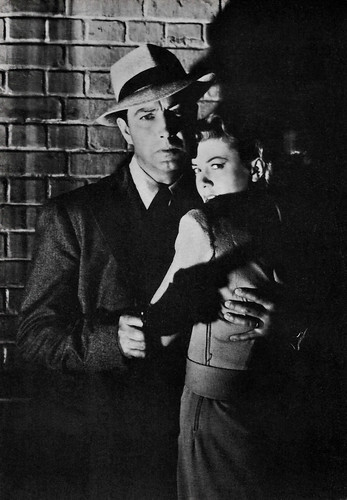
Italian postcard in the Divi e Divine series by La Casa Usher. Robert Taylor and Audrey Totter in High Wall (Curtis Bernhardt, 1947). The card refers mistakenly to Robert Taylor 's film The Power and the Prize (Henry Koster, 1956).
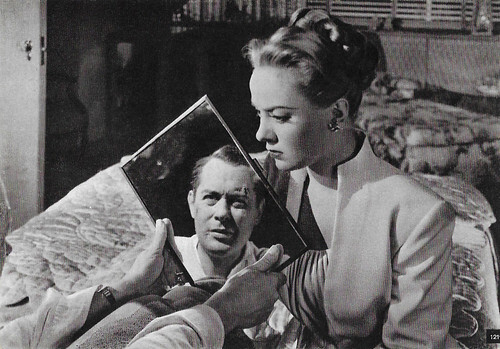
Italian postcard, no. 121. Photo: Metro Goldwyn Mayer. Audrey Totter and Robert Montgomery in The Lady in the Lake (Robert Montgomery, 1947).

Italian postcard, no. 1222. Photo: Metro Goldwyn Mayer. Robert Montgomery and Audrey Totter in The Lady in the Lake (Robert Montgomery, 1947).
John Garfield's blonde floozie pick-up
Audrey Mary Totter was born in Joliet, in northeastern Illinois, in 1917. Her parents were John Totter, who was born in Slovenia with birth name Janez, and Ida Mae Totter. She had two brothers, Folger and George, and a sister, Collette. Totter graduated from Joliet High School, where she acted in school plays.
She was a Methodist who began her career performing in several productions for her local church, as well as being involved with the YWCA players. Totter continued her acting career in radio in the late 1930s in Chicago, only 40 miles northeast of Joliet. She played in soap operas, including 'Painted Dreams', 'Ma Perkins', and 'Bright Horizon'.
She moved on to film when MGM offered her a seven-year film contract. She made her film debut as a 'bad girl' in Main Street After Dark (Edward L. Cahn, 1945) and established herself as a popular female lead in the 1940s. The Postman Always Rings Twice (Tay Garnett, 1946) with John Garfield and Lana Turner , was the first Film Noir in which she appeared. Totter had a small role as John Garfield's blonde floozie pick-up.
Although she performed in various film genres, she became most widely known to movie audiences for her work in Film Noir. She co-starred in Lady in the Lake (Robert Montgomery, 1947) starring Montgomery as Detective Philip Marlowe. The film was not well received and is now better remembered for its interesting subjective camera technique. Audrey's first hit as a femme fatale co-star came on loan-out to Warner Bros. In The Unsuspected (Michael Curtiz, 1947) starring Claude Rains , she cemented her dubious reputation in "B" noir as a trampy, gold-digging niece married to alcoholic Hurd Hatfield.
She then starred in High Wall (Curtis Bernhardt, 1947), as a psychiatrist to patient Robert Taylor , The Saxon Charm (Claude Binyon, 1948) with Robert Montgomery (again) and Susan Hayward , and Alias Nick Beal (John Farrow, 1949) as a loosely-moraled 'Girl Friday' to Ray Milland . Totter played other successful roles in the boxing drama The Set-Up (Robert Wise, 1949) as the beleaguered wife of washed-up boxer Robert Ryan , and in Tension (John Berry, 1949) as the two-timing spouse of Richard Basehart . Looking back, Totter stated in 1999, "The bad girls were so much fun to play. I wouldn't have wanted to play the Coleen Gray good-girl parts."
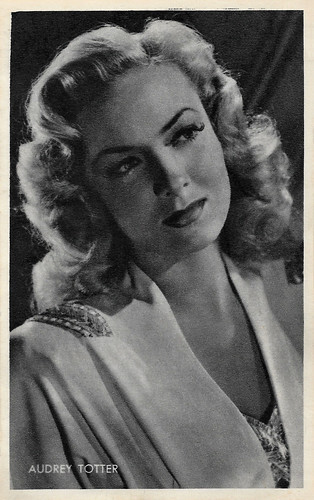
Belgian collector card by Kwatta, Bois d'Haine, no. C. 105 (Series C. 99 - 196). Photo: Metro Goldwyn Mayer.
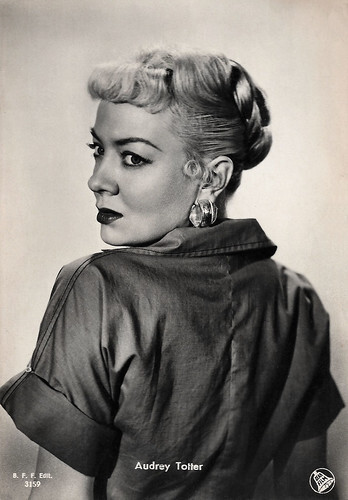
Italian postcard, no. 121. Photo: Dear Film. Audrey Totter in A Bullet for Joey (Lewis Allen, 1955).
One of filmdom's most intriguing ladies
By the early 1950s, the tough-talking 'dames' Audrey Totter was best known for portraying were no longer fashionable. She reportedly was dissatisfied with her MGM career and agreed to appear in Any Number Can Play (Mervyn LeRoy, 1949) only after Clark Gable intervened. MGM began streamlining its roster of contract players and worked towards creating more family-themed films.
Totter was released from her contract in 1951. She worked for Columbia Pictures and 20th Century Fox, but the quality of her films dropped. From the early 1950s, she increasingly acted in television series. In 1958, Totter played boarding house owner Beth Purcell in the Western series, Cimarron City, starring George Montgomery.
Later she appeared in episodes of such series as Alfred Hitchcock Presents (1960), Perry Mason (1964), Rawhide and The Virginian. Totter had a continuing role from 1972 to 1976, playing Nurse Wilcox, the efficient head nurse, in the series Medical Center, with James Daly and Chad Everett. The last time she appeared in front of the camera was as a nun in the episode Old Habits Die Hard (1987) of the mystery series Murder, She Wrote starring Angela Lansbury .
Audrey Totter was married to Dr. Leo Fred, Assistant Dean of Medicine at UCLA, from 1953 to his death in 1995. They had one child, Mae Lane. In 2013, Totter died of congestive heart failure at the Motion Picture and Television Hospital, Woodland Hills, Califonia, eight days before her 96th birthday. After a memorial service, her body was cremated and her ashes were scattered in the Pacific.
Gary Brumburgh at IMDb : "One is certainly hard-pressed to think of another true 'bad girl' representative so closely identifiable with film noir than hard-looking blonde actress Audrey Totter. While she remained a "B"-tier actress for most of her career, she was an "A" quality actress and one of filmdom's most intriguing ladies. She always managed to set herself apart even in the most standard of programming."
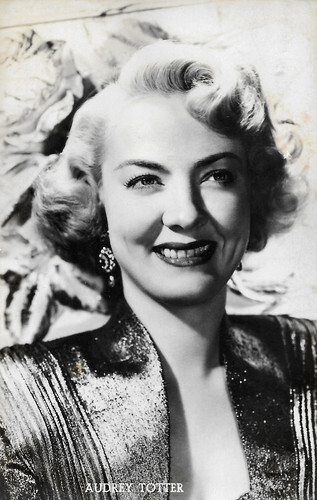
Vintage postcard, no. 351. Photo: Metro Goldwyn Mayer.
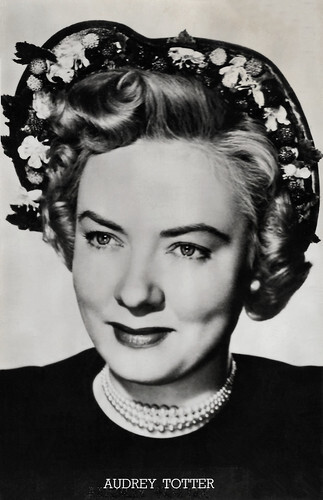
Vintage postcard, no. 951. Photo: Metro Goldwyn Mayer.
Sources: Wikipedia (Dutch, German and English) and .

Italian postcard in the Divi e Divine series by La Casa Usher. Robert Taylor and Audrey Totter in High Wall (Curtis Bernhardt, 1947). The card refers mistakenly to Robert Taylor 's film The Power and the Prize (Henry Koster, 1956).

Italian postcard, no. 121. Photo: Metro Goldwyn Mayer. Audrey Totter and Robert Montgomery in The Lady in the Lake (Robert Montgomery, 1947).

Italian postcard, no. 1222. Photo: Metro Goldwyn Mayer. Robert Montgomery and Audrey Totter in The Lady in the Lake (Robert Montgomery, 1947).
John Garfield's blonde floozie pick-up
Audrey Mary Totter was born in Joliet, in northeastern Illinois, in 1917. Her parents were John Totter, who was born in Slovenia with birth name Janez, and Ida Mae Totter. She had two brothers, Folger and George, and a sister, Collette. Totter graduated from Joliet High School, where she acted in school plays.
She was a Methodist who began her career performing in several productions for her local church, as well as being involved with the YWCA players. Totter continued her acting career in radio in the late 1930s in Chicago, only 40 miles northeast of Joliet. She played in soap operas, including 'Painted Dreams', 'Ma Perkins', and 'Bright Horizon'.
She moved on to film when MGM offered her a seven-year film contract. She made her film debut as a 'bad girl' in Main Street After Dark (Edward L. Cahn, 1945) and established herself as a popular female lead in the 1940s. The Postman Always Rings Twice (Tay Garnett, 1946) with John Garfield and Lana Turner , was the first Film Noir in which she appeared. Totter had a small role as John Garfield's blonde floozie pick-up.
Although she performed in various film genres, she became most widely known to movie audiences for her work in Film Noir. She co-starred in Lady in the Lake (Robert Montgomery, 1947) starring Montgomery as Detective Philip Marlowe. The film was not well received and is now better remembered for its interesting subjective camera technique. Audrey's first hit as a femme fatale co-star came on loan-out to Warner Bros. In The Unsuspected (Michael Curtiz, 1947) starring Claude Rains , she cemented her dubious reputation in "B" noir as a trampy, gold-digging niece married to alcoholic Hurd Hatfield.
She then starred in High Wall (Curtis Bernhardt, 1947), as a psychiatrist to patient Robert Taylor , The Saxon Charm (Claude Binyon, 1948) with Robert Montgomery (again) and Susan Hayward , and Alias Nick Beal (John Farrow, 1949) as a loosely-moraled 'Girl Friday' to Ray Milland . Totter played other successful roles in the boxing drama The Set-Up (Robert Wise, 1949) as the beleaguered wife of washed-up boxer Robert Ryan , and in Tension (John Berry, 1949) as the two-timing spouse of Richard Basehart . Looking back, Totter stated in 1999, "The bad girls were so much fun to play. I wouldn't have wanted to play the Coleen Gray good-girl parts."

Belgian collector card by Kwatta, Bois d'Haine, no. C. 105 (Series C. 99 - 196). Photo: Metro Goldwyn Mayer.

Italian postcard, no. 121. Photo: Dear Film. Audrey Totter in A Bullet for Joey (Lewis Allen, 1955).
One of filmdom's most intriguing ladies
By the early 1950s, the tough-talking 'dames' Audrey Totter was best known for portraying were no longer fashionable. She reportedly was dissatisfied with her MGM career and agreed to appear in Any Number Can Play (Mervyn LeRoy, 1949) only after Clark Gable intervened. MGM began streamlining its roster of contract players and worked towards creating more family-themed films.
Totter was released from her contract in 1951. She worked for Columbia Pictures and 20th Century Fox, but the quality of her films dropped. From the early 1950s, she increasingly acted in television series. In 1958, Totter played boarding house owner Beth Purcell in the Western series, Cimarron City, starring George Montgomery.
Later she appeared in episodes of such series as Alfred Hitchcock Presents (1960), Perry Mason (1964), Rawhide and The Virginian. Totter had a continuing role from 1972 to 1976, playing Nurse Wilcox, the efficient head nurse, in the series Medical Center, with James Daly and Chad Everett. The last time she appeared in front of the camera was as a nun in the episode Old Habits Die Hard (1987) of the mystery series Murder, She Wrote starring Angela Lansbury .
Audrey Totter was married to Dr. Leo Fred, Assistant Dean of Medicine at UCLA, from 1953 to his death in 1995. They had one child, Mae Lane. In 2013, Totter died of congestive heart failure at the Motion Picture and Television Hospital, Woodland Hills, Califonia, eight days before her 96th birthday. After a memorial service, her body was cremated and her ashes were scattered in the Pacific.
Gary Brumburgh at IMDb : "One is certainly hard-pressed to think of another true 'bad girl' representative so closely identifiable with film noir than hard-looking blonde actress Audrey Totter. While she remained a "B"-tier actress for most of her career, she was an "A" quality actress and one of filmdom's most intriguing ladies. She always managed to set herself apart even in the most standard of programming."

Vintage postcard, no. 351. Photo: Metro Goldwyn Mayer.

Vintage postcard, no. 951. Photo: Metro Goldwyn Mayer.
Sources: Wikipedia (Dutch, German and English) and .
Published on April 08, 2024 22:00
April 7, 2024
Photo by Hanni Schwarz
Hanni Schwarz was a German portrait, dance and nude photographer, who was active in Berlin from 1901 onwards. She was a well-known professional photographer in the German Empire at the beginning of the twentieth century. During the 1920s, Ross Verlag and Verlag Hermann Leisewr featured many of her studio's film star portraits on their postcards.
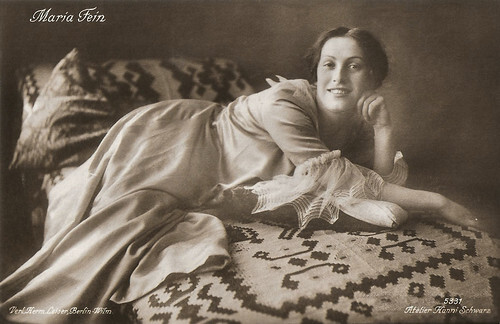
German postcard by Verlag Hermann Leiser, Berlin-Wilm., no. 5331. Photo: Atelier Hanni Schwarz. Maria Fein .
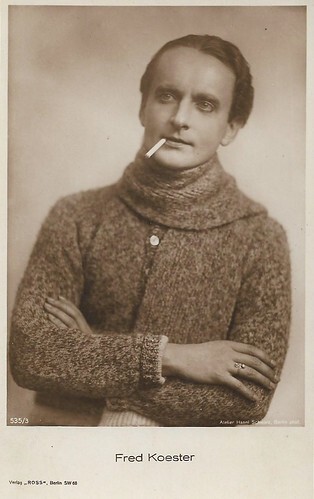
German postcard by Ross Verlag, Berlin, no. 535/3, 1919-1924. Photo: Atelier Hanni Schwarz, Berlin. Fred Köster.
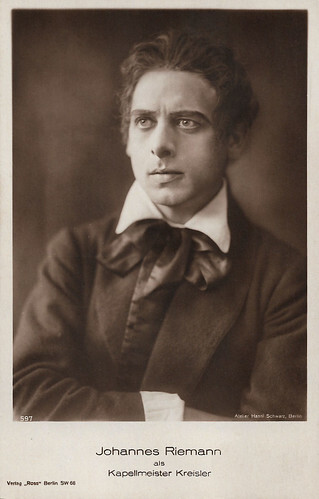
German postcard by Ross Verlag, no. 597, 1919-1924. Photo: Hanni Schwarz, Berlin. Johannes Riemann as Kapelmeister Kreisler. Kapellmeister Kreisker may refer to Tales of Hoffmann.
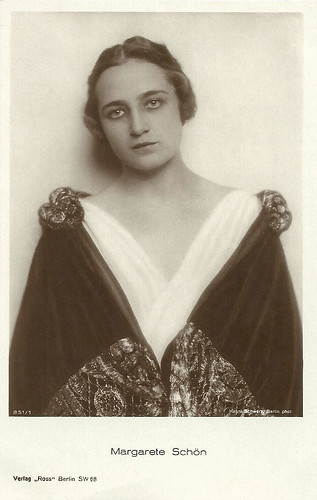
German postcard by Ross Verlag, no. 851/1, 1925-1926. Photo: Hanni Schwarz, Berlin. Margarete Schön .
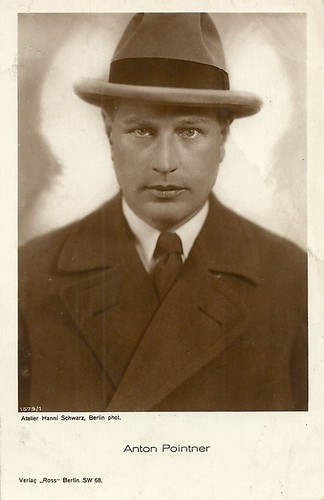
German postcard by Ross Verlag, no. 1579/1, 1927-1828. Photo: Atelier Hanni Schwarz. Anton Pointner .
A so-called beauty evening
Hanni Schwarz's life dates are unknown. Before turning to photography, Schwarz worked as a teacher at her father’s school in Basel.
In 1901, Hanni began to work as a portrait photographer in Berlin. Around 1904, she took over the photography studio of Johannes Hülsen in Berlin, together with fellow photographer Anna Walter.
In 1905, Schwarz wrote an article for Photographische Mitteilungen about photography as a profession for women. In her article 'Photographie als Frauenberuf', she honoured pioneer photographer Emilie Bieber, the founder of Atelier Bieber, who had passed away in 1884.
In April 1908, a so-called beauty evening took place in the Mozartsaal of the Neues Schauspielhaus. Nude photographs by Hanni Schwarz and Wilhelm von Gloeden were presented, and projected onto a screen. Around 1909, Schwarz ran her studio with Marie Luise Schmidt in the Dorotheenstraße in Berlin.
A portrait Hanni Schwarz had made of the artist Fidus appeared in a book edited by Adalbert Luntowski in 1910. In the same year, In 1910 she participated in the Brussels International 1910 with nude photographs. Colour photographs of her were shown at the 'Bugra" in 1914. Hanni Schwarz had made a name for herself in Berlin as a fine art photographer.
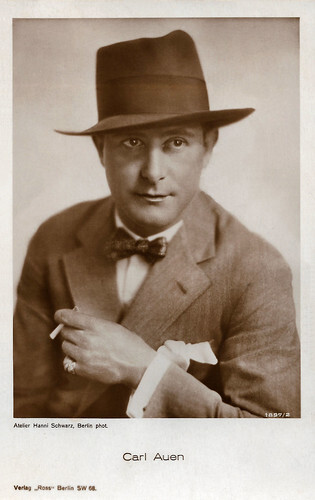
German postcard by Ross Verlag, no. 1897/2, 1927-1928. Photo: Hanni Schwarz, Berlin. Carl Auen .
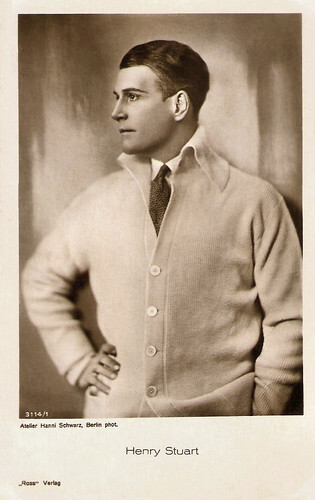
German postcard by Ross Verlag, no. 3114/1, 1928-1929. Photo: Atelier Hanni Schwarz, Berlin. Henry Stuart .
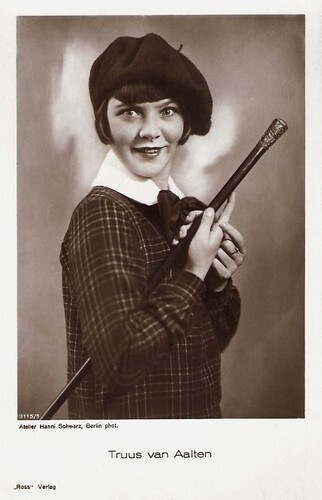
German postcard by Ross Verlag, no. 3115/1, 1928-1929. Photo: Atelier Hanni Schwarz, Berlin. Truus van Aalten .
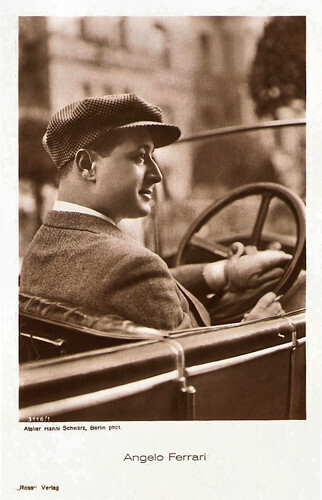
German postcard by Ross Verlag, no. 3116/1, 1928-1929. Photo Atelier Hanni Schwarz, Berlin. Angelo Ferrari .
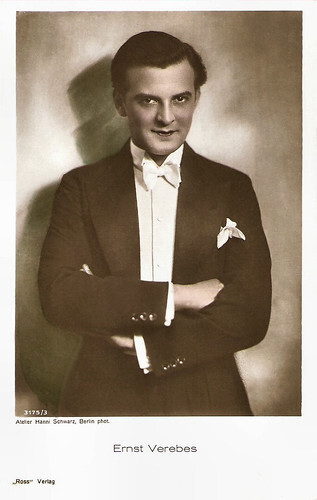
German postcard by Ross Verlag, no. 3175/3, 1928 - 1929. Photo: Atelier Hanni Schwarz, Berlin. Ernö or Ernst Verebes .
Europe’s premiere film star postcard publisher in the 1920s
From 1919 onwards, the studio at the Dortheenstrasse was listed as the Atelier Hanni Schwarz. The studio specialised in portraiture and dance photography. Photographs by Atelier Hanni Schwarz were frequently published in several popular magazines, such as Die Schönheit (from 1903 on) and Sport im Bild.
Ross-Verlag in Berlin, Europe’s premiere film star postcard publisher in the 1920s and 1930s, printed numerous portraits taken by Atelier Hanni Schwarz of famous actors, such as the Russian film actor Vladimir Gajdarov (1917-1968), Hungarian film actor Imre Ráday (1905-1983) and Dutch actress Truus van Aalten (1910-1999), who were all working in the German film industry at the time.
In the 1920s, Atelier Hanni Schwarz was managed by 'Fräulein Igoleit', who also specialised in portrait and dance photography. She had joined the company on 18 October 1919. Frida Igoleit was born on 11 October 1884 in Königsberg and the last entry about her is that of her de-registration to America on 26 March 1932.
The cancellation of the company can be dated to 13 November 1936. In a 1919 questionnaire, Igogeit describes the studio as located in a 7-room flat, consisting of 2 large workrooms, 2 studio rooms, 1 laboratory, 1 darkroom and 1 reception room. The number of employees is given as 6-8 people, 10-12 suppliers and 800-900 customers.
The most recent photographs attributable to Atelier Hanni Schwarz date from 1930, after which the studio's photos no longer appeared in magazines or on postcards. In 2000, works by Hanni Schwarz were included in the exhibition 'Le siècle du corps. Photographies 1900-2000' at the Musée de l'Elysée in Lausanne.
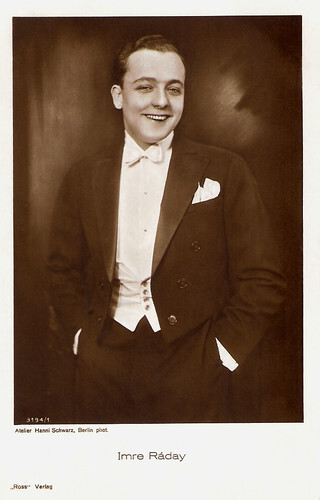
German postcard by Ross Verlag, no. 3194/1, 1928-1929. Photo: Hanni Schwarz, Berlin. Imre Ráday .
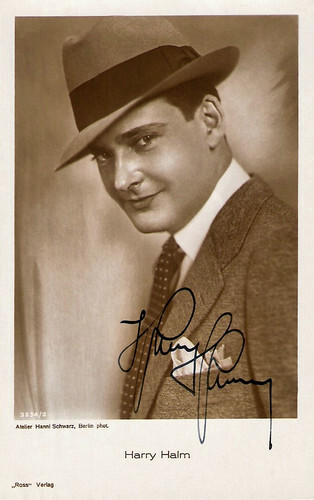
German postcard by Ross Verlag, no. 3234/2, 1928-1929. Photo: Atelier Hanni Schwarz, Berlin. Harry Halm .
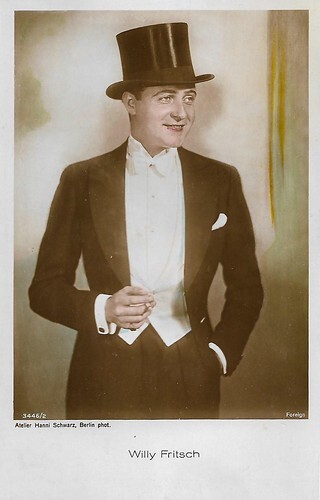
German postcard by Ross Verlag in the Foreign Series, no. 3446/2, 1928-1929. Photo: Atelier Hanni Schwarz, Berlin. Willy Fritsch .
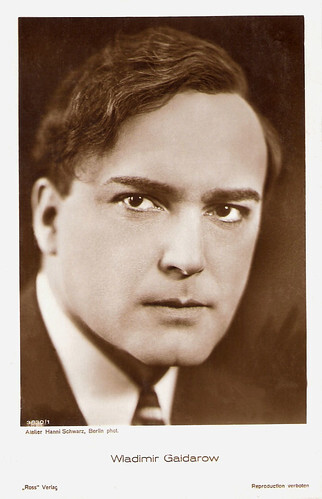
German postcard by Ross Verlag, no. 3830/1, 1928-1929. Photo: Atelier Hanni Schwarz, Berlin. Vladimir Gajdarov .
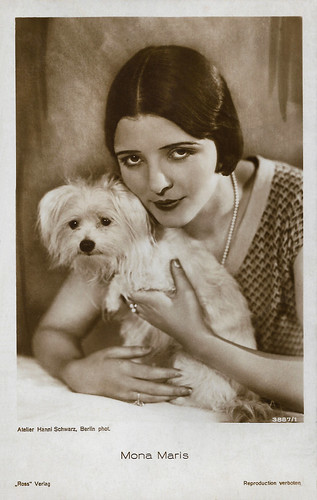
German postcard by Ross Verlag, no. 3887/1, 1928-1929. Photo: Hanni Schwarz, Berlin. Mona Maris .
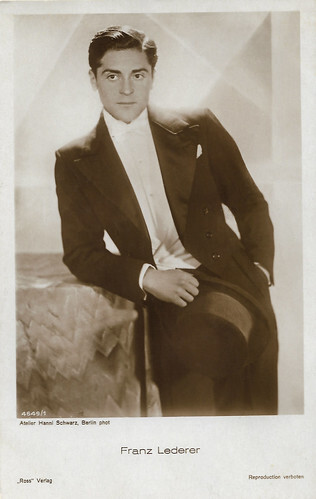
German postcard by Ross Verlag, no. 4649/1, 1929-1930. Photo: Atelier Hanni Schwarz, Berlin. Franz or Francis Lederer .
Sources: Hanni Schwarz (Photografische Mitteilungen - German), Deutsche Fotothek (German), Sisters of the Lens and Wikipedia.

German postcard by Verlag Hermann Leiser, Berlin-Wilm., no. 5331. Photo: Atelier Hanni Schwarz. Maria Fein .

German postcard by Ross Verlag, Berlin, no. 535/3, 1919-1924. Photo: Atelier Hanni Schwarz, Berlin. Fred Köster.

German postcard by Ross Verlag, no. 597, 1919-1924. Photo: Hanni Schwarz, Berlin. Johannes Riemann as Kapelmeister Kreisler. Kapellmeister Kreisker may refer to Tales of Hoffmann.

German postcard by Ross Verlag, no. 851/1, 1925-1926. Photo: Hanni Schwarz, Berlin. Margarete Schön .

German postcard by Ross Verlag, no. 1579/1, 1927-1828. Photo: Atelier Hanni Schwarz. Anton Pointner .
A so-called beauty evening
Hanni Schwarz's life dates are unknown. Before turning to photography, Schwarz worked as a teacher at her father’s school in Basel.
In 1901, Hanni began to work as a portrait photographer in Berlin. Around 1904, she took over the photography studio of Johannes Hülsen in Berlin, together with fellow photographer Anna Walter.
In 1905, Schwarz wrote an article for Photographische Mitteilungen about photography as a profession for women. In her article 'Photographie als Frauenberuf', she honoured pioneer photographer Emilie Bieber, the founder of Atelier Bieber, who had passed away in 1884.
In April 1908, a so-called beauty evening took place in the Mozartsaal of the Neues Schauspielhaus. Nude photographs by Hanni Schwarz and Wilhelm von Gloeden were presented, and projected onto a screen. Around 1909, Schwarz ran her studio with Marie Luise Schmidt in the Dorotheenstraße in Berlin.
A portrait Hanni Schwarz had made of the artist Fidus appeared in a book edited by Adalbert Luntowski in 1910. In the same year, In 1910 she participated in the Brussels International 1910 with nude photographs. Colour photographs of her were shown at the 'Bugra" in 1914. Hanni Schwarz had made a name for herself in Berlin as a fine art photographer.

German postcard by Ross Verlag, no. 1897/2, 1927-1928. Photo: Hanni Schwarz, Berlin. Carl Auen .

German postcard by Ross Verlag, no. 3114/1, 1928-1929. Photo: Atelier Hanni Schwarz, Berlin. Henry Stuart .

German postcard by Ross Verlag, no. 3115/1, 1928-1929. Photo: Atelier Hanni Schwarz, Berlin. Truus van Aalten .

German postcard by Ross Verlag, no. 3116/1, 1928-1929. Photo Atelier Hanni Schwarz, Berlin. Angelo Ferrari .

German postcard by Ross Verlag, no. 3175/3, 1928 - 1929. Photo: Atelier Hanni Schwarz, Berlin. Ernö or Ernst Verebes .
Europe’s premiere film star postcard publisher in the 1920s
From 1919 onwards, the studio at the Dortheenstrasse was listed as the Atelier Hanni Schwarz. The studio specialised in portraiture and dance photography. Photographs by Atelier Hanni Schwarz were frequently published in several popular magazines, such as Die Schönheit (from 1903 on) and Sport im Bild.
Ross-Verlag in Berlin, Europe’s premiere film star postcard publisher in the 1920s and 1930s, printed numerous portraits taken by Atelier Hanni Schwarz of famous actors, such as the Russian film actor Vladimir Gajdarov (1917-1968), Hungarian film actor Imre Ráday (1905-1983) and Dutch actress Truus van Aalten (1910-1999), who were all working in the German film industry at the time.
In the 1920s, Atelier Hanni Schwarz was managed by 'Fräulein Igoleit', who also specialised in portrait and dance photography. She had joined the company on 18 October 1919. Frida Igoleit was born on 11 October 1884 in Königsberg and the last entry about her is that of her de-registration to America on 26 March 1932.
The cancellation of the company can be dated to 13 November 1936. In a 1919 questionnaire, Igogeit describes the studio as located in a 7-room flat, consisting of 2 large workrooms, 2 studio rooms, 1 laboratory, 1 darkroom and 1 reception room. The number of employees is given as 6-8 people, 10-12 suppliers and 800-900 customers.
The most recent photographs attributable to Atelier Hanni Schwarz date from 1930, after which the studio's photos no longer appeared in magazines or on postcards. In 2000, works by Hanni Schwarz were included in the exhibition 'Le siècle du corps. Photographies 1900-2000' at the Musée de l'Elysée in Lausanne.

German postcard by Ross Verlag, no. 3194/1, 1928-1929. Photo: Hanni Schwarz, Berlin. Imre Ráday .

German postcard by Ross Verlag, no. 3234/2, 1928-1929. Photo: Atelier Hanni Schwarz, Berlin. Harry Halm .

German postcard by Ross Verlag in the Foreign Series, no. 3446/2, 1928-1929. Photo: Atelier Hanni Schwarz, Berlin. Willy Fritsch .

German postcard by Ross Verlag, no. 3830/1, 1928-1929. Photo: Atelier Hanni Schwarz, Berlin. Vladimir Gajdarov .

German postcard by Ross Verlag, no. 3887/1, 1928-1929. Photo: Hanni Schwarz, Berlin. Mona Maris .

German postcard by Ross Verlag, no. 4649/1, 1929-1930. Photo: Atelier Hanni Schwarz, Berlin. Franz or Francis Lederer .
Sources: Hanni Schwarz (Photografische Mitteilungen - German), Deutsche Fotothek (German), Sisters of the Lens and Wikipedia.
Published on April 07, 2024 22:00
Paul van Yperen's Blog
- Paul van Yperen's profile
- 13 followers
Paul van Yperen isn't a Goodreads Author
(yet),
but they
do have a blog,
so here are some recent posts imported from
their feed.



